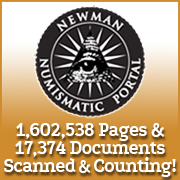
About UsThe Numismatic Bibliomania Society is a non-profit organization devoted to the study and enjoyment of numismatic literature. For more information please see our web site at coinbooks.org SubscriptionsThose wishing to become new E-Sylum subscribers (or wishing to Unsubscribe) can go to the following web page link MembershipThere is a membership application available on the web site Membership Application To join, print the application and return it with your check to the address printed on the application. Print/Digital membership is $40 to addresses in the U.S., and $60 elsewhere. A digital-only membership is available for $25. For those without web access, write to: Terry White, Treasurer AsylumFor Asylum mailing address changes and other membership questions, contact Terry at this email address: terrywhite5475@yahoo.com SubmissionsTo submit items for publication in The E-Sylum, just Reply to this message, or write to the Editor at this address: whomren@gmail.com BUY THE BOOK BEFORE THE COINSale Calendar |
- WAYNE'S WORDS: THE E-SYLUM NOVEMBER 1, 2017
- KOLBE & FANNING SHELF CLEARANCE SALE
- COLONIAL NEWSLETTER AUGUST 2017 ISSUE PUBLISHED
- ROMAN COIN PORTRAITS WINS TOP IAPN PRIZE
- NEWMAN/BREEN CORRESPONDENCE ON NEWMAN PORTAL
- NEWMAN PORTAL SEARCH: BETTS-111
- SENATORS QUIZ MINT DIRECTOR CANDIDATE DAVID RYDER
- BRUSSELS MINT TO CLOSE
- HAPPY HALLOWEEN 2017
- SHIRE POST MINT HIGHLIGHTS SPOOKY COINS
- FIFTH AVENUE NEW YORK COIN DEALERS
- NOTES FROM E-SYLUM READERS: OCTOBER 29, 2017
- ROB RODRIGUEZ ON THE CONTINENTAL DOLLARS
- LOVE TOKEN BRACELET PHOTOGRAPHIC HISTORY
- VOCABULARY TERM: ANONYMOUS
- DICK JOHNSON INVITES CRITICS
- ADOLF IKLé-STEINLIN (1852-1923)
- ROGER BLAND SPEAKS AT HARVARD
- U.S. MINT ARTIST CHESTER MARTIN REMINISCES
- ROYAL AUSTRALIAN MINT ROAD SHOW
- HISTORICAL MISSOURI SCRIP IN NEWMAN PART VIII
- FOUR SIGNIFICANT CONFEDERATE PIECES TO BE SOLD
- NUMISMATIC NUGGETS: OCTOBER 29, 2017
- WAYNE'S NUMISMATIC DIARY: OCTOBER 29, 2017
- DIX NOON WEBB OFFERING EARLY PROOF SETS
- MUSEUM OF LONDON EXHIBITS ALTERNATIVE CURRENCY
- STATUE DEDICATED TO DICKIN MEDAL DOG
Click here to access the complete archive
To comment or submit articles, reply to whomren@gmail.com
Content presented in The E-Sylum is not necessarily researched or independently fact-checked, and views expressed do not necessarily represent those of the Numismatic Bibliomania Society.
WAYNE'S WORDS: THE E-SYLUM NOVEMBER 1, 2017
 New subscribers this week include: Agustin Munoz. Welcome aboard! We now have 3,296 subscribers.
New subscribers this week include: Agustin Munoz. Welcome aboard! We now have 3,296 subscribers.
Thank you for reading The E-Sylum. If you enjoy it, please send me the email addresses of friends you think may enjoy it as well and I'll send them a subscription with your compliments. Contact me at whomren@gmail.com anytime regarding your subscription, or questions, comments or suggestions about our content.
My apologies to some of you who have sent submissions this week - I wasn't able to get everything in here in the time available. With luck I'll catch up next week.
This week we open with a numismatic literature clearance sale, a new Colonial Newsletter, top book prizes from IAPN, updates from the Newman Numismatic Portal and Mint news from around the world.
Other topics this week include spooky Halloween coins, Fifth Avenue coin dealers, love token bracelets, Adolf Iklé, Chester Martin, Roger Bland, Missouri obsolete paper money, early Royal Mint proof sets, and the Dickin medal.
To learn more about the Connecticut State Mint, Islamic coins in Rhode Island, Roman Coin Portraits, the Badger Mint, the Black Skull of Crom, the 1776 Mint at Philadelphia, the 1887 National Indian Ball Game, Confederate half dollar restrike die trial pieces, Andy Warhol Art Cash, and The Future of Digitization, read on. Have a great week, everyone!
Wayne Homren
Editor, The E-Sylum
KOLBE & FANNING SHELF CLEARANCE SALE
Help Us Make Room for New Books!
We are offering the following George Frederick Kolbe / Kolbe & Fanning titles at a 50% discount for a limited time to clear shelf space for new stock. Get them at these great prices before they're gone!

To read the complete article, see:
Clearance Books 50% Off
(https://www.numislit.com/advSearchResults.php?action=search&orderBy=relevance&category_id=0&keywordsField=clearance)
COLONIAL NEWSLETTER AUGUST 2017 ISSUE PUBLISHED
 The American Numismatic Society (ANS) is pleased to announce the publication of the latest issue of The Colonial Newsletter (CNL). Founded in 1960, CNL has continuously published
some of the most scholarly and seminal studies in the area of Colonial numismatics. Editor, Christopher McDowell, states that “this just might be the best issue ever.”
The American Numismatic Society (ANS) is pleased to announce the publication of the latest issue of The Colonial Newsletter (CNL). Founded in 1960, CNL has continuously published
some of the most scholarly and seminal studies in the area of Colonial numismatics. Editor, Christopher McDowell, states that “this just might be the best issue ever.”
Throughout 2017, CNL has been publishing transcripts of the newly discovered accounting books for the Connecticut State Mint. These documents are a treasure trove of information on the inner-workings of the mint between 1787 and 1788. Issue 164 includes the first half of the transcript of the 1787 Connecticut mint accounting records. Mr. McDowell notes that “this document provides more than just the numbers of coins produced, it also give us the names of all the mint employees along with wage and cost data. With these records we can fully understand for the first time how the mint operated.”
Issue 164 also includes an article based on the accounting records regarding Jack Arabas, a former slave and Revolutionary War soldier who worked at the mint in 1787. This article tells the story of Jack's struggle for freedom after the war and how his fight resulted in freedom for hundreds of other slaves who served with bravery and honor in the Continental Army.
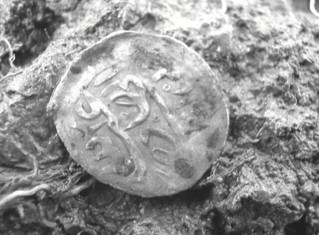 The feature article in CNL-164 is written by a metal-detectorist, James Bailey, who uncovered an Islamic coin in Rhode Island dating from 1693 and spent several years figuring out how it
got there. What Mr. Bailey's quest reveals is the amazing story of how pirates brought a king's ransom in silver and jewels to the New World in the late 1690s. By piecing together finds of other
Arabic coins located by detectorist throughout New England and examining shipping records, Royal Proclamations, wills, and other primary source materials, Mr. Bailey makes a convincing case that
these coins circulated in the Colonies for a brief period of time and significantly impacted the economy.
The feature article in CNL-164 is written by a metal-detectorist, James Bailey, who uncovered an Islamic coin in Rhode Island dating from 1693 and spent several years figuring out how it
got there. What Mr. Bailey's quest reveals is the amazing story of how pirates brought a king's ransom in silver and jewels to the New World in the late 1690s. By piecing together finds of other
Arabic coins located by detectorist throughout New England and examining shipping records, Royal Proclamations, wills, and other primary source materials, Mr. Bailey makes a convincing case that
these coins circulated in the Colonies for a brief period of time and significantly impacted the economy.
To subscribe to The CNL, please visit numismatics.org/store or call 212-571-4470 for more details.
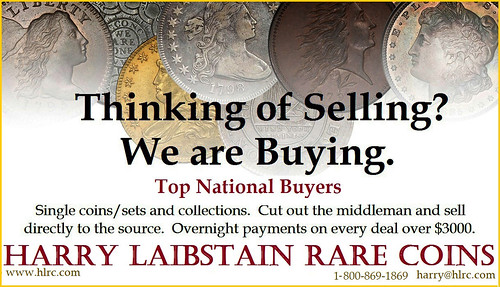
ROMAN COIN PORTRAITS WINS TOP IAPN PRIZE
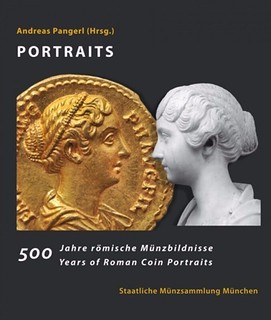 1st Prize
1st Prize
Pangerl, Andreas, Portraits: 500 Years of Roman Coin Portraits, Staatliche Münzsammlung München (Munich, GER) 2017, ISBN 978-3-922840-36-7. Price: €60.
2nd Prize
Day, William R. Jr., Matzke, Michael, Saccocci, Andrea, Medieval European Coinage (Volume 12: Northern Italy), Cambridge University Press (NYC, U.S.A.) 2017, ISBN 978-0521260213. Price:
$265.
3rd Prize
Thesen, Gunnar, Norges mynter i dansketiden 1449-1814, Bookwell Ltd (Porvoo, FIN) 2015, ISBN 978-82- 690202-0-5. Price: €100
To read the complete article, see:
I.A.P.N. Annual Conference 2017 in Lucerne (http://coinsweekly.com/index.php?pid=4&id=4992)
To read the earlier E-Sylum article, see:
NEW BOOK: PORTRAITS - 500 YEARS OF ROMAN COIN PORTRAITS (http://www.coinbooks.org/v20/esylum_v20n17a04.html)
For more infomration about IAPN, see:
http://www.iapn-coins.org/
NEWMAN/BREEN CORRESPONDENCE ON NEWMAN PORTAL
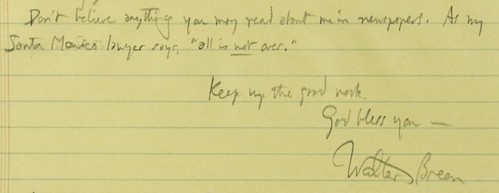
Eric P. Newman and Walter Breen maintained a numismatic correspondence from 1951 until Breen's death in 1993 in a prison hospital. Breen initiated the first contact, writing to Newman in January 1951 about Newman's article on Fugio cent varieties from the January 1949 Coin Collector's Journal. Newman was impressed with Breen's observations relative to Fugio cents in the Smithsonian, and so began their exchange. In 1952, Newman sent his U.S. half cents (many ex. Col. Green) to the ANS for Breen's examination, and the discussion moves on to Vermont coppers, Nova Constellatios, Virginia coinage, and other topics. An active dialogue of early American numismatics continues through the 1960s before trailing off in the 1970s.
In 1984 Breen shares a draft of a portion of his Encyclopedia, and in 1988 Newman congratulates Breen upon the publication of a “monumental work,” noting “its bibliographical references, its illustrations and its indices are a pleasure to behold.” Newman also anticipates the work will not be universally accepted, as “differences of opinion are natural and you will probably get your share of such comments or challenges as you well realize. I naturally have some such differences.” Still, Eric intended to “refer to it in any future research or writing I do in relevant areas.”
The conclusion of the file isn’t pleasant, recounting Breen's legal, financial, and health problems. These have been widely reported, and there is no whitewashing to be done. Breen is unrecognizable (“you would not recognize me…I didn’t recognize my own face in the mirror…”) and unrepentant (“the current charges against me are false & trumped up……don’t believe anything you may read about me in newspapers….”). The correspondence closes on December 27, 1992. Breen passed away on April 27, 1993.
Link to Newman/Breen correspondence on Newman Portal:
https://nnp.wustl.edu/library/archivedetail/522453
NEWMAN PORTAL SEARCH: BETTS-111
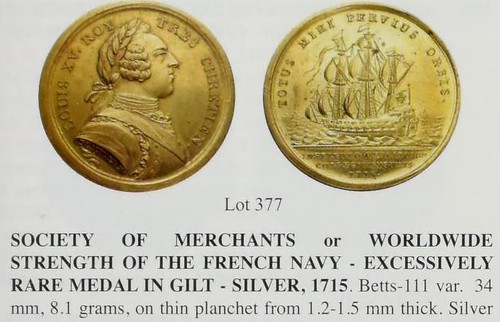
Presidential Auction #85 (June 2015), lot 77
An NNP user recently searched for Betts-111, “Betts” referring of course to C. Wyllys Betts’ American Colonial History Illustrated by Contemporary Medals (1894), which catalogs 623 such pieces. John Kraljevich and Erik Goldstein conducted a related exercise at their recent ANA Summer Seminar course in colonial numismatics. Students were randomly assigned 3-digit numbers and instructed to prepare a 5-minute presentation on the Betts medal of the same number. We can report that this exercise resulted in several searches of the Newman Portal.
In any case, Betts-111, the Society of Merchants medal by Duvivier, depicts Louis XV and is dated 1715. A search of the Newman Portal reveals but a single citation, in Joe Levine's Presidential Coin & Antique Auction #85 (June 2015), lot 77, where he cataloged a gilt silver example as excessively rare, and missing from the LaRivere, Ford, and Adams collections. Levine noted only two examples, this and another apparently in the Bibliothèque Nationale.
Link to Presidential Coin and Antique Sale #85 on Newman Portal:
https://nnp.wustl.edu/library/auctionlots?AucCoId=511514&AuctionId=511937&page=76
Link to Betts’ American Colonial History on Newman Portal:
https://nnp.wustl.edu/library/book/519282
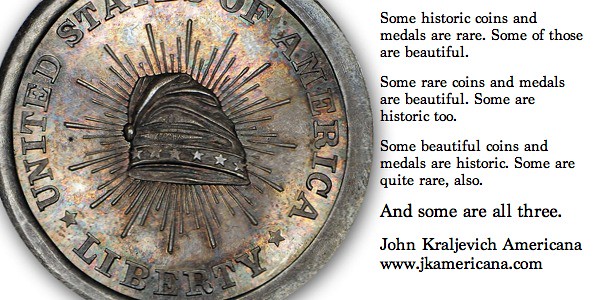
SENATORS QUIZ MINT DIRECTOR CANDIDATE DAVID RYDER

Should he be confirmed as the 39th director of the United States Mint, David J. Ryder said among his top priorities would be combating sophisticated, high-quality counterfeiting of United States bullion coins.
Ryder's remark came in response to a question posed by Sen. Thom Tillis, R-N.C., during Ryder's Oct. 24 nomination hearing before the Senate Banking, Housing and Urban Affairs Committee.
Tillis asked Ryder what he believed the future of coins is over the next 20 to 30 years. Ryder responded he didn’t feel coins were going away any time soon, but the Mint has to respond to technology challenges and how they apply to coins and where coins are used in commerce.
Ryder has spent the past 25 years in the private sector working on anti-counterfeiting and security measures involving coins and paper money since leaving the government after a 14-month stint as the 34th Mint director.
To read the complete article, see:
Ryder says measures to combat counterfeiting of U.S. bullion coins top priority
(https://www.coinworld.com/news/us-coins/2017/10/us-mint-director-nominee-faces-senate-scrutiny.all.html)
BRUSSELS MINT TO CLOSE
Belgium will stop making Euro coins at the end of this year
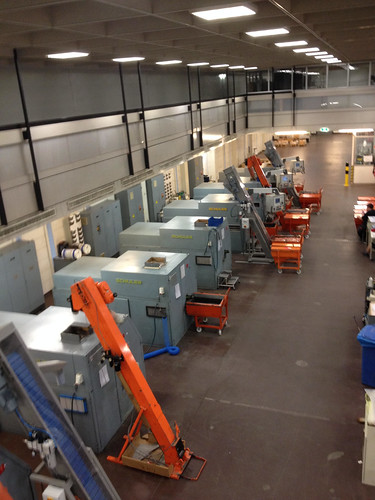
A portion of the press room at the Brussels mint shows eight high-capacity presses that will soon be in some other nation's mint.
Wanna buy a late-model coin press? Belgium is closing its modern mint in Brussels as of the end of this year and selling off its coin manufacturing assets. This surprising bit of news we got during a visit to the mint to present a copy of my English-Spanish numismatic dictionary, El Numiscadero to the mint's library.
The executive who gave us a brief tour noted that while the coining operations will be abandoned in less than 90 days, the $60,000 per month lease for the large modern building will continue for three more years as a government expense.
Belgium is one of the smallest nations in the EU, perhaps one reason why it was originally selected as the headquarters for the grand union of nations here. Letting France or Germany be the center of attention apparently would have been just too obvious.
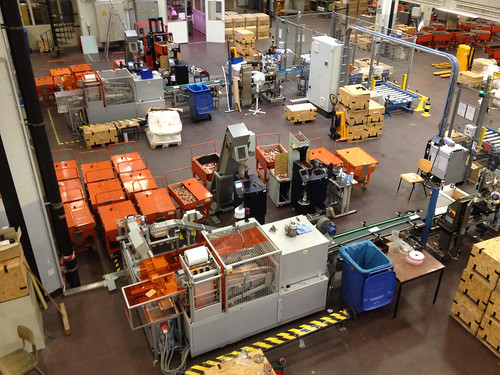
As at all modern mints, freshly struck coins are rolled and packaged for delivery to banks.
* 25 October: definitive closing of the web shop on www.europemint.eu, after which there will no further opportunity to order with the RMB.
Following the restructuring of the Royal Mint of Belgium our webshop will be closed from this moment onwards. We would like to thank you for your confidence in our services and will keep you informed about the future developments within the Royal Mint of Belgium.
To visit the Royal Mint of Belgium web site (English), see:
http://www.europemint.eu/en_2.htm
For more information on Gary's book, see:
NEW BOOK: EL NUMISCADERO (http://www.coinbooks.org/v20/esylum_v20n03a02.html)
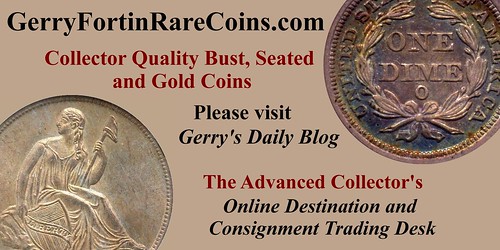
HAPPY HALLOWEEN 2017
George Cuhaj's Halloween Tokens
George Cuhaj of Iola, WI writes:
On and off I have made nickel sized pewter tokens for the Trick or Treat kids of Iola.
A common obverse is paired with a reverse legend side with a "helpful" popular saying and a date. Early examples were cast pewter in a mold made from sample pieces of the DuPont table top product corian.
Later examples were made from dies cut by my Badger Mint partner Joe Paonessa. My initials GC are in the pumpkin's eyes. Usually 300 are made and distributed.
No token this year - I've been giving out sea shells, as they are skeletons.
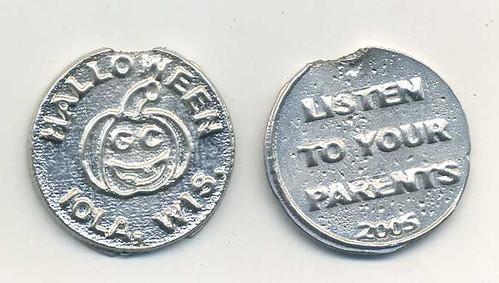
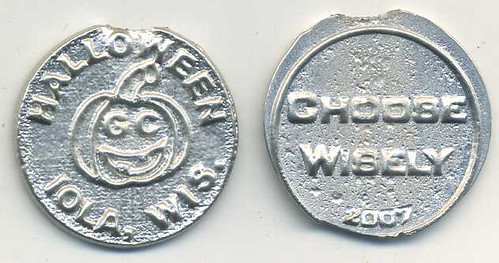
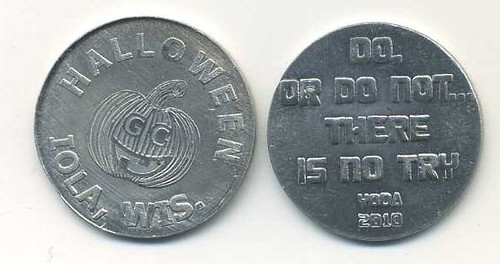
For more information on the Badger Mint, see:
https://www.facebook.com/Badger-Mint-98014314320/
Heads Impaled on Pikes
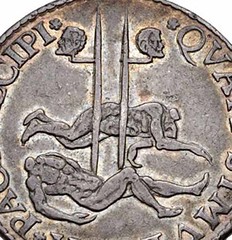
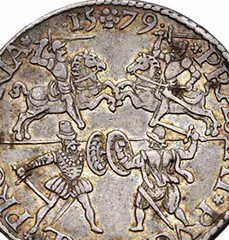
QVAM SIMVLATA PACE DECIPI (“how pretense of peace to deceive”), decapitated corpses of Egmont and Horn; above, heads impaled on pikes. Low Countries, Nederlands Opstand (Dutch Revolt – 1566/8-1581).
To read the complete lot description, see:
Heads Impaled on Pikes - Low Countries, Nederlands - Struck 1579
(https://www.ebay.com/itm/Heads-Impaled-on-Pikes-Low-Countries-Nederlands-Struck-1579-/282691031331)
Happy Halloween! Now enjoy these snippets from earlier E-Sylum articles on the topic. -Editor
The Beistle Company
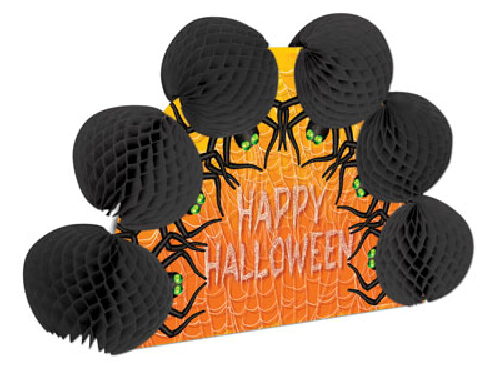
The Beistle Company was founded in 1900 in Pittsburgh, Pennsylvania by Martin Luther Beistle. "M.L." began a company that grew to become one of today's largest American Halloween novelty producers.
M.L. gave birth to the company in the basement of his Pennsylvania home crafting decor for hotel lobbies with his wife and brother-in-law. In the beginning, Beistle lines consisted mainly of artificial plants and wooden products. M.L. kept his job as a calendar salesman while the company "got off it's feet". It was not long before he was able to purchase the company for whom he had worked.
The firm saw a brief setback during the financial collapse of 1907, and M.L. moved his company and family back to his home in south central Pennsylvania.
The company soon rallied however and moved quarters to a wagon shop owned by M.L.'s father-in-law. Beistle was able to move to yet another new headquarters in Shippensburg, Pennsylvania shortly thereafter.
M.L. made a shrewd business move in 1910, when he brought the technology to produce honeycombed tissue to the United States. This technology had formerly only been available in Europe and the Orient. He built and patented new machines for this process.
The new honeycombed tissue was a hit. Beistle rapidly expanded their production lines of paper decorations and the business thrived.
The Dance of Death
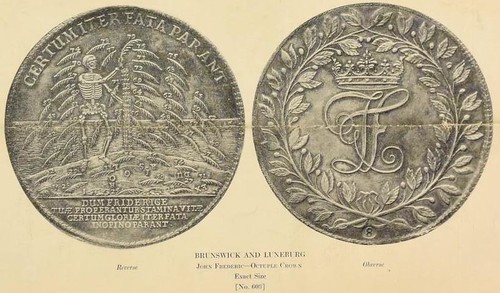
Without doubt one of the more macabre items we’ve handled on the Newman Numismatic Portal recently came through the scanning queue at the American Numismatic Society, which partners with the Newman Portal on digitization. The American Art Association, a New York firm, in 1922 published the auction catalog A notable collection of coins and medals bearing emblems illustrative of “The Dance of Death,” collected by Miss Susan Minns of Boston, Mass. Skulls, skeletons, and dead bodies are littered throughout the cabinet, which must have been quite the conversation starter between Miss Minns and her acquaintances. The plates are halftones but illustrate the concept well enough.
To read earlier E-Sylum articles, see:
COINS FOR HALLOWEEN (http://www.coinbooks.org/esylum_v07n43a17.html)
ZOMBUCKS: CURRENCY OF THE APOCALYPSE (http://www.coinbooks.org/esylum_v18n44a41.html)
M. L. BEISTLE AND THE BEISTLE COMPANY (http://www.coinbooks.org/esylum_v19n44a35.html)
NEWMAN PORTAL SCANS DANCE OF DEATH CATALOG (http://www.coinbooks.org/v20/esylum_v20n28a07.html)
SHIRE POST MINT HIGHLIGHTS SPOOKY COINS
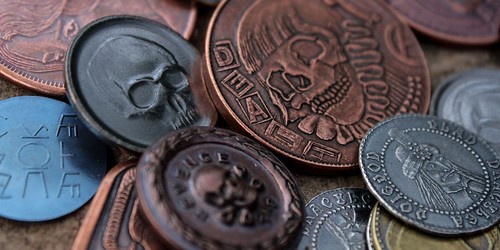
This month we've been busy with our Mistborn Kickstarter, but I took a quick break to create a collection of some of the spooky, scary coins Shire Post Mint has created over the years. These coins feature vampires, devils, pirates, aliens, and of course, the ever-present skulls.
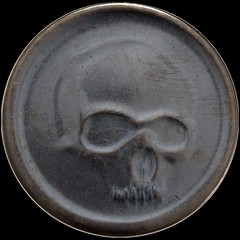
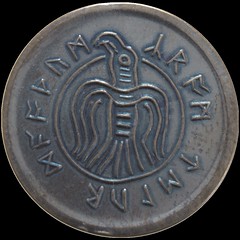
One special coin we've included is the Black Skull of Crom. You've seen it before in the Conan Set #1, now you can get it all by itself. The coin is nickel bronze, but has a unique patina making it completely black and incredibly glossy. Pictures just don't do this coin justice.
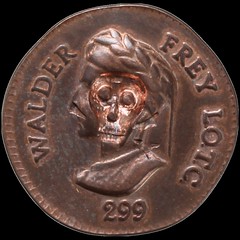
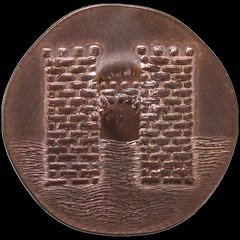
Another coin we're offering is the "Death's Head" Walder Frey Penny, a coin countermarked with the spectral visage of Death's Head, an attempt to protect the user of the cursed coin of oathbreaker Frey. These coins are fairly old, so when I found them hiding in our back stock I thought they'd be perfect to make available in time for Halloween. Unfortunately we only have a few left, so quantities are extremely limited. Still, these older Shire Post coins are too neat not to share. We have quite a few other cool Shire Post coins in the collection that are perfect for this time of year, so be sure to check them out. If you can think of another cool or creepy coin we've overlooked, reach out to us on social media and let us know what you'd like to see!
To read the complete article, see:
Spooky, Scary Coins from Shire Post Mint!
(https://www.shirepost.com/blogs/news/spooky-scary-coins-from-shire-post-mint)
For more Shire Post Mint Halloween coins, see: Halloween Coins (https://www.shirepost.com/collections/halloween-coins)
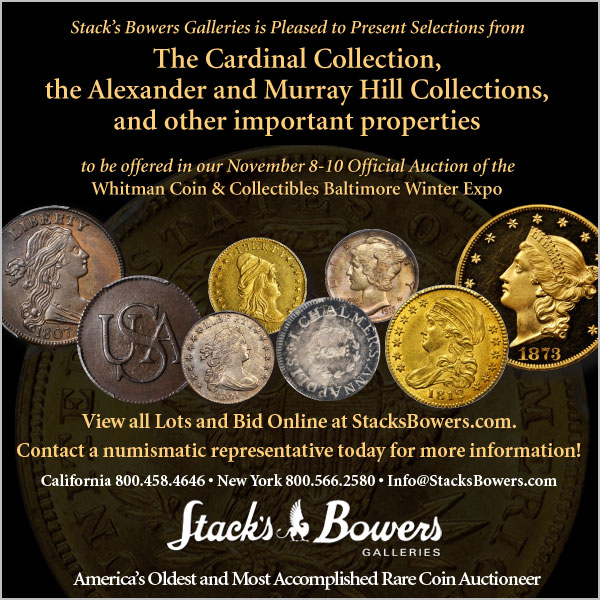
FIFTH AVENUE NEW YORK COIN DEALERS
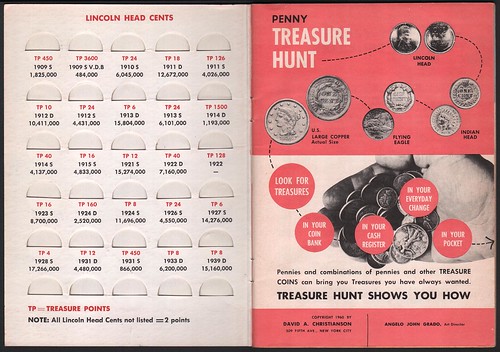
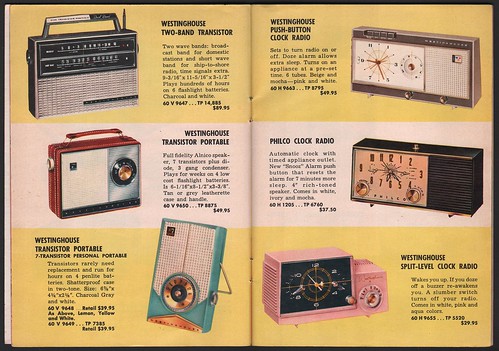
In addition to collecting coin boards, folders and albums I also collect any literature that tells the story of popular coin collecting during its golden years, 1930s-60s. I'm attaching images of a 1960 catalog that offers to redeem collectible Indian Head or Lincoln Cents submitted to its publisher with general merchandise. This scheme worked the same as the old Blue Chip and Green Stamp gift books. Each cent was assigned a point value, and the many consumer goods illustrated in the catalog required a certain number of points. The deal definitely worked in favor of the publisher, as a simple transistor radio of the kind I had as a kid required more than the total point value of two 1909-S VDB cents!
While I was enjoying this purchase, I noticed something intriguing about the address of publisher David A. Christianson, 509 Fifth Avenue, New York City. This building was right next door to 507, the address of Colonial Coin & Stamp Company, publisher of coin boards 1935-42! It appears that there was something of a coin dealer row thing going on there, though perhaps not at the same time. I'm attaching a circa 1940 photo showing, from right to left, 505-507-509 Fifth Avenue. These buildings were across the street from NYC's main library but were replaced with a single, modern high rise sometime after 1980. A blowup of the photo reveals Colonial Coin & Stamp Company's Statue of Liberty logo on the second or third floor of Number 505, with the word STAMP just barely readable below it.
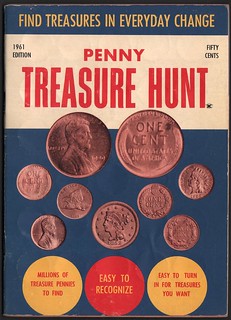
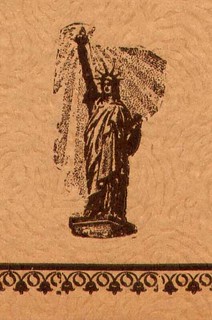
Left: Treasure Hunt board front cover
Right: Colonial Coin & Stamp Company board detail
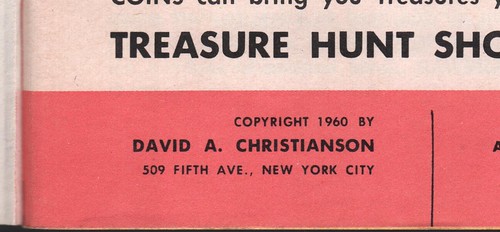
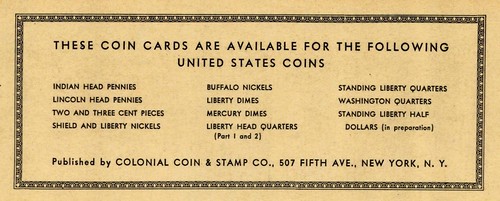
Left: Treasure Hunt address
Right: Colonial Coin & Stamp Company address
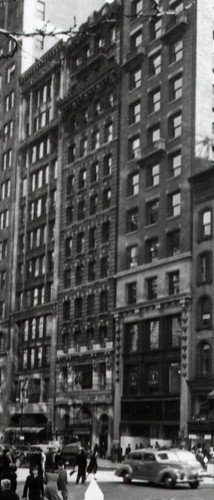
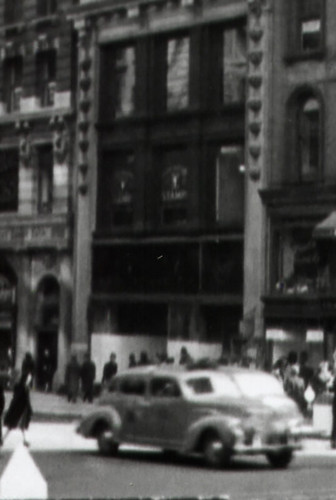
NOTES FROM E-SYLUM READERS: OCTOBER 29, 2017
Happy Birthday, Illustrium Imagines
Joel Orosz writes:
I am suggesting that birthday greetings be published in The E-Sylum, not for a person, but rather for a book. In my "Numismatic Bookie" column in the September 18, 2017 issue of Coin World, I discussed the first book published in the Western world illustrated by images of coins and medals, Illustrium Imagines. There are two issues of Illustrium, the first printed on November 7, 1517, and the second printed on November 15, 1517. It seems highly appropriate, in a few day's time, to celebrate the 500th birthday of this truly illustrious example of numismatic literature.
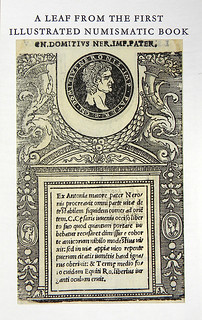 My column discussed the only widely accessible way to add Illustrium Imagines, or at least a fragment thereof, to one's library, namely the leaf book published by George
Frederick Kolbe in 2001. Kolbe salvaged 151 of Giovanni Battista Palumba's 204 woodcuts from an imperfect copy of Illustrium, and printed 151 books that showcase a single Palumba woodcut.
The book also reprints "Nota," an essay by the Renaissance scholar Roberto Weiss, on the life and times of Andrea Fulvio, Illustrium's publisher. This leaf book was letterpress printed
by Henry Morris, and bound by the Campbell-Logan bindery, so it is a work of art that encloses a piece of history.
My column discussed the only widely accessible way to add Illustrium Imagines, or at least a fragment thereof, to one's library, namely the leaf book published by George
Frederick Kolbe in 2001. Kolbe salvaged 151 of Giovanni Battista Palumba's 204 woodcuts from an imperfect copy of Illustrium, and printed 151 books that showcase a single Palumba woodcut.
The book also reprints "Nota," an essay by the Renaissance scholar Roberto Weiss, on the life and times of Andrea Fulvio, Illustrium's publisher. This leaf book was letterpress printed
by Henry Morris, and bound by the Campbell-Logan bindery, so it is a work of art that encloses a piece of history.
Whether you have an intact copy or a leaf book, please remember to wish a half-millennium birthday to Illustrium Imagines on November 7 and again on November 15.
The Legend of the Yoachum Dollar
Regarding the Yoachum Dollar legend, Bob Leonard writes:
I exhaustively researched this story in the 1980s, and presented my findings in a 41-minute program at the ANA Numismatic Theater in Orlando in 1992, "Legend of the Yoachum Dollar," which was videotaped. The ANA Library should have a copy, and David Lisot may still have copies for sale. A condensed version, "The Legend of the Yoachum Dollar,” was published in Numismatist March 1994: 373-378, 447-449, 457, and took a Third Place Heath Literary Award plus the Wayte and Olga Raymond Memorial Award. I also wrote an ANA Money Talks radio script on this subject.
This is a looong story, but basically I looked at many variations of the legend and concluded that there was some truth to it, and that some members of the Yoachum family were in fact making counterfeit Mexican Cap and Rays pesos in the 1840s. No silver mine, though, and I debunked all the fakes.
To read the earlier E-Sylum article, see:
CHICKASAW BIG KEYS AND THE YOCUM SILVER DOLLAR (http://www.coinbooks.org/v20/esylum_v20n43a10.html)
The Swedish-American Friendship Medal

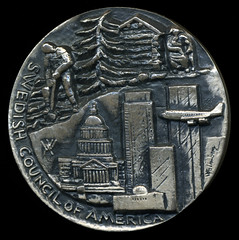
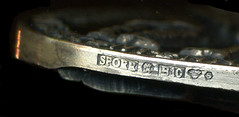
I doubt the US Mint has ever been tempted to use a standard set of Swedish hallmarks.
SPORR = Sporrong, a prolific Swedish manufacturer of medals among many other products, including tie clips and other jewelry. http://www.sporrong.com/gallery/medaljer-jetonger/
City mark which I'm having trouble making out, it may be Kungsbacka's ornate "K" in a circle, but it doesn't look quite right. Digging into Sporrong's corporate history would probably help.
B10 = 1976
3 crowns in trefoil followed by "S" = silver item manufactured in Sweden (after 1988 also used for imported items)
And, no, the medal should be solid silver, probably .830 purity.
To read the earlier E-Sylum article, see:
NOTES FROM E-SYLUM READERS: OCTOBER 22, 2017 : The Swedish-American Friendship Medal
(http://www.coinbooks.org/v20/esylum_v20n43a09.html)
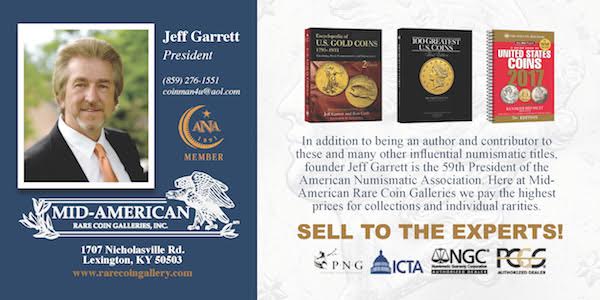
ROB RODRIGUEZ ON THE CONTINENTAL DOLLARS
Having read the various comments over the past few issues of The E-Sylum, I would like to chime in with some thoughts of my own.
First, my colleague and friend, Dr. Joel Orosz, provides a ca. 1783-84 quote from Pierre Eugene Du Simitiere that says Continental Dollars were struck in London. Because Du Simitiere discussed coins with a number of knowledgeable European visitors to his museum in Philadelphia, the implication is that Du Simitiere had direct knowledge about the origin of the Continental Dollars. This is a fallacious assumption. Du Simitiere was undoubtedly repeating a story that had been told to him, and there is no way to judge the reliability of his source. In any case, this source could be regarded as being in the area of hearsay. In contrast, I have several newspapers from the month of December 1776 that carry the following news story or an abridged version of it:
The London Chronicle, December 21, 1776: “Letters from an officer of the 64 th Reg. In York Island to his friend in town. The Congress have established a Mint at Philadelphia, where they coin copper and silver pieces about the size of a half crown. In silver go for twelve shillings, in copper for fourteen pence.”

From the American Journal of Numismatics, October 1891, p45
Other British papers reporting this news in December included, The Saint James Chronicle, Lloyd's Evening Post, The Scots Magazine and The Public Advertiser.

St. James Chronicle, December 21, 1776. Page 3
A knowledgeable researcher I spoke to about this newspaper information questioned its accuracy since he said that CDs are generally about the size of a British crown, or 40 mm. When I questioned whether this diameter measurement applied to the brass CDs as well, there was a question in his mind. When he checked his records, he had weight measurements and not diameters. The Resolute Americana Collection owns four brass, two each of the Newman 1-A and 1-B varieties, respectively. They range in size between 36.9 and 37.8 mm, with an average diameter of 37.4 mm. When visually compared to a crown and half-crown from the 1740s, it is obvious the brass CDs fit between them on a size comparison. It seems realistic to assume that there were more circulating half-crowns than crowns in Continental America; therefore, referencing their size to a half-crown would appear to be reasonable.
The size of the brass specimens might be of some importance because news stories reported speculation about a potential new copper coin from late June 1776 to early July 1776. During this period, the terms brass and copper were used interchangeably.
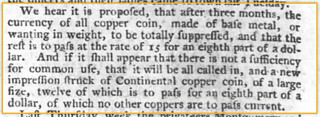
For example, The Pennsylvania Gazette, July 3, 1776, reporting news from New York of July 1 put forth the following: “We hear it proposed, that after three months, the currency of all copper coin, made of base metal, or wanting in weight, to be totally suppressed......And if it shall appear that there is not a sufficiency for common use, that it will be called in, and a new impression struck of Continental copper coin of a large size......”. Thus, at this time there was a discussion occurring about potential Continental coinage. Benjamin Franklin owned this newspaper. To have a news report about a potential new copper coin in his newspaper the day before the Declaration of Independence is probably something we should consider as being important. The timing for this possible new coin would also relate well to that which was reported in the British newspapers in December.
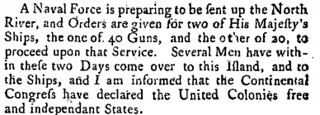 If the news account of the possible silver and copper coins appears meager, given its potential importance as a challenge to British sovereignty, I offer the following story as a
comparison. The London Gazette, August 6 to August 10, 1776, provides among the first news accounts of the Declaration of Independence. This report was of such immense importance that it was
carried in the seventh paragraph, second sentence, second column and it was about equivalent in length to the second half of the sentence from The London Chronicle, regarding the mint and
coinage, or 33 words.
If the news account of the possible silver and copper coins appears meager, given its potential importance as a challenge to British sovereignty, I offer the following story as a
comparison. The London Gazette, August 6 to August 10, 1776, provides among the first news accounts of the Declaration of Independence. This report was of such immense importance that it was
carried in the seventh paragraph, second sentence, second column and it was about equivalent in length to the second half of the sentence from The London Chronicle, regarding the mint and
coinage, or 33 words.
Second, Jonathan Odell's poem, “The Congratulation,” is of significance since it does reference “pewter dollars.” Mr. Tom Wetter discounts this since he references a book from 1769 that mentions “pewter dollars.” I do not know in what context the term was used but in the case of Odell's poem, there is little question about it. Over the course of six pages of poetry, the author's contempt for the Continental Congress and all that it represents continuously builds. Prior to referencing “pewter dollars,” he writes the following,
“Dollars on dollars heap’ do up to the skies, Their value sinks the more, the more they rise.”
He then finishes his sarcastic attack with one on “pewter dollars” in the final seven lines of the poem. I do not view this as an accident. By the way, the poem was published twice that month.
In another classic Odell poem, “The American Times, Part III,” published between September and October 1780, in Rivington's Royal Gazette, he writes,
“Knave after knave as easy we could join, As new emissions of the paper coin.”
Notice how he highlights “emissions of the paper coin” so the reference to “pewter dollars” should be viewed in the context of his attacks on the mounting paper money and paper coin. Jonathan Odell was the pre-eminent loyalist poet of the time and was well followed. He was a former physician in the British army, a clergyman, a gentleman and was a highly respected member of the community. His loyalty toward the king grew throughout the war. He and Joseph Stansbury, another leading poet, were both involved with aiding in the defection of General Benedict Arnold. Odell escaped to Canada while Arnold made it to England.
Third, thank you to Mr. Tom Wetter for providing the letter and additional information about this wonderful book that you can order on Amazon, “1700s in America,” first published in 1784, which Bob Keathley brought to light by having his rare copy translated from the original German. I have now given away nearly 300 copies to high-school students and adults since I view it as one of the best and earliest descriptions of Revolutionary America. The American Revolution was a big news item in Germany and imagery was used to help better convey the importance and idealism of the Revolution.

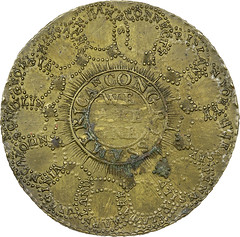
Newman 1-A Continental Dollar
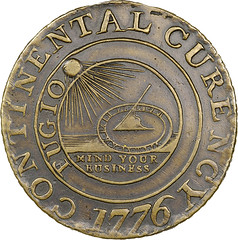
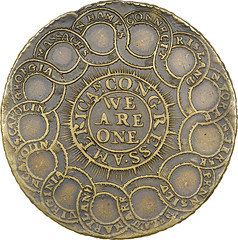
Newman 1-B Continental Dollar
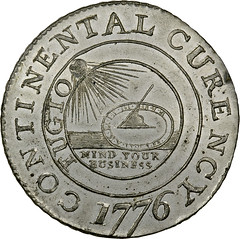
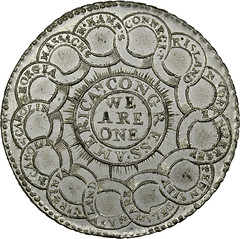
Newman 1-C Continental Dollar
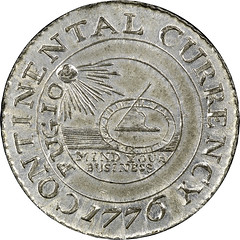
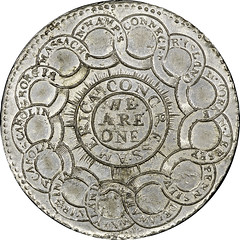
Newman 2-C Continental Dollar
The CD imaged in the book is a Newman 2-C variety, which means “Curency” has now been corrected to read “Currency” and Massachusetts is still listed before New Hampshire. The order of these two colonies was reversed, corrected, with the Newman 3-D variety. In my opinion, the timing of the book publishing would not have allowed the 2-C variety to have been coined and then copied for publication. The timeframe would have been too tight; therefore, it already had to be in existence.
If this coin were meant for sale in America or Europe, why worry about the spelling? Most people would not know the difference. There are seven different Newman die varieties. If this was intended to be a medal to be sold cheaply, why go through all this trouble? Additionally, because of the various die rotations, this indicates a die re-alignment and change had to occur several times.
I recently had my pewter 1-A, a Heritage Auction's discovery in 2015, cracked out so as to investigate its edge design. I discovered that it has a plain edge and its die rotation is identical to that of the brass 1-A that has an ornamental edge. This is an indication that a single set of dies could be used to strike different denominations that are differentiated by the metal utilized. This occurred again with the 1-C variety but this time the difference is between a plain edge pewter versus a silver with edge ornamentation. There are several examples of single die designs with identical planchet size that used metal, silver and copper, to differentiate between denominations. Examples include the 1785 Inimica Tyannis America, 1785 Immune Columbia and the 1792 Getz pattern coins.
I also think a comment should be included regarding the crudeness of pewter dollar coinage and engraving. When one compares a pewter dollar to coins and medals that were minted in Europe around that time, the differences are obvious. One only has to view a Betts-610, Treaty of Paris medal, to see the difference in quality, though a plain edge was used for both the silver and pewter varieties. The pewter Betts-614, Treaty of Paris, also suffers by comparison. Though it looks and feels like a pewter Continental Dollar, there are a couple of subtle design differences. The edge design is different from that of the pewter dollars. Upon closer inspection, the reverse is differentiated in two ways. First, there are three dots between the “N” and “C” of American and Congress and second, there is a star between Congress and America. Finally, it uses the earlier reverse design, as it appeared on the 1-C and 2-C varieties.
Lastly, Bob Leonard submitted notes on Catherine Eagleton's 2015 Numismatic Chronicle article, “Collecting America: Sarah Sophia Banks and the ‘Continental Dollar’ of 1776.” There is a hand written notation in the Sarah Sophia Banks catalogue (1815) that states, “Continental Dollar. 1776. never current, struck on speculation in Europe, for sale in America.” This comment was above an advertisement offering them for sale at sixpence each. First, there is no indication from what publication the ad came from or its date. Second, no one has, including myself, found a copy of the ad in an intact publication, which means we do not have a confirmation of its authenticity. For an excellent critique of Eagleton's article, I refer you to The E-Sylum, June 14, 2015, volume 18, to read, “A few Notes on Catherin Eagleton's Numismatic Chronicle Article on the Continental Dollar,” by David F. Fanning.
In summary, I believe variations in design, metal type, crudeness, newspaper coinage references, Jonathan Odell's poems and the volume, “1700s in America,” indicate these mysterious coins are something more than what we currently understand them to be; however, my research convinces me that they are from the period as minted. I would like to offer one last observation. The Continental Dollars are the coins that capture a student's imagination among all the rare coins I bring for a classroom presentation. Today, when it seems as though many are highlighting our differences, the simple message conveyed on the Continental Dollar's reverse, “WE ARE ONE,” encapsulates the goal and spirit of our emerging country.
Thank you,
Robert Rodriguez
To read earlier E-Sylum articles, see:
TRANSLATION OF THE 1783 CHARLES SPENER LETTER (http://www.coinbooks.org/v20/esylum_v20n43a11.html)
ONGOING THOUGHTS ON THE CONTINENTAL DOLLAR (http://www.coinbooks.org/v20/esylum_v20n43a12.html)
LOVE TOKEN BRACELET PHOTOGRAPHIC HISTORY
Love token bracelet photographs are one of the harder items to find. Many old photos are of either portraits or groups of people. With portraits it is rare to have a hand shown near the face unless perhaps it is holding a fan... With hands often being obscured in poses, issues in lighting or focus, sometimes clothing covering the wrists, and the jewelry being so small in these head to toe photos, it makes it very difficult to find love token bracelet period photographs.
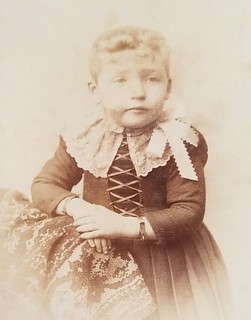 The following photos represent about twenty years of searching for these elusive images. The first image is of a young child wearing a matching pair of buckle style band bracelets made from
a thin sheet metal, composition unknown. The bracelets appear to be the same type that is used with the band/buckle style love token bracelets but no coins are visible. There was a period of time
when matching bangles or bands were the fashion and they lacked love tokens.
The following photos represent about twenty years of searching for these elusive images. The first image is of a young child wearing a matching pair of buckle style band bracelets made from
a thin sheet metal, composition unknown. The bracelets appear to be the same type that is used with the band/buckle style love token bracelets but no coins are visible. There was a period of time
when matching bangles or bands were the fashion and they lacked love tokens.
Other love token photos will support that it was popular to wear these love token bracelets with gloves. Additional research should be done on gloves in Victorian fashion with the heights of popularity, if they were worn regularly both inside and outside of the home, and if weather/climate influenced the fashion. The other item of interest is that one woman is wearing a Kimono. There was a period when all things Japanese greatly influenced design in the Victorian period, but that is a whole other topic worthy of a separate article.
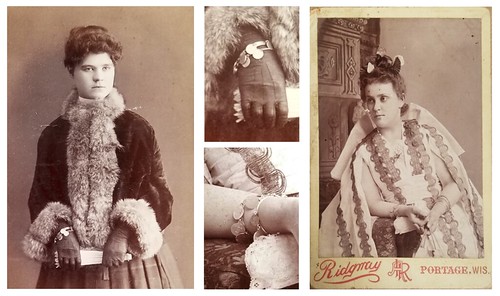
The previous photos are all what are called “cabinet cards” or “cabinet photos”. They measure roughly 4.25” x 6.5” with thin photographic paper mounted on rigid cardboard. The name and location of the photographic studio is generally printed on the obverse of the cards and occasionally there is additional information of the studio on the reverse and is sometimes accompanied with graphics. None of these cards have printed reverses but one has a name and date handwritten on the reverse which dates it to 1892. There was a large surge of love tokens made this year which coincides with the anniversary of Columbus discovering the new world and also the release of the new “Barber” design coinage. These events may have triggered more interest in having love tokens made.
For more information about the Love Token Society, see:
http://lovetokensociety.com/
To read earlier E-Sylum articles, see:
BANGLES: SELLING COINS FOR MAKING LOVE TOKENS (http://www.coinbooks.org/v20/esylum_v20n18a14.html)
HOW LOVE TOKEN ENGRAVING STYLES CHANGED (http://www.coinbooks.org/esylum_v18n34a25.html)
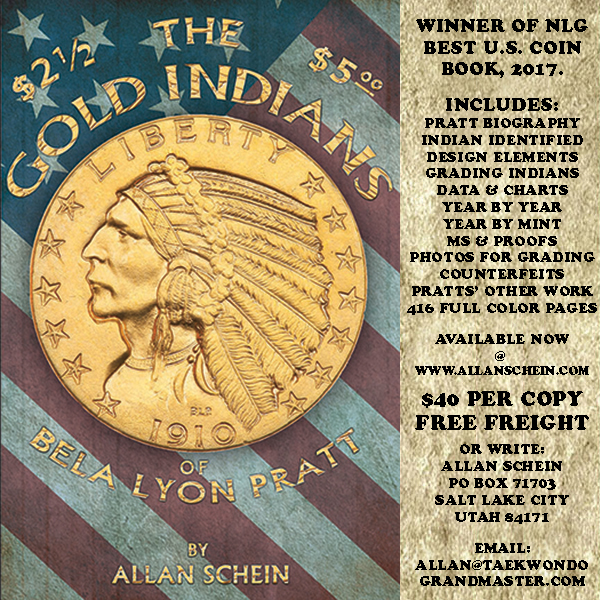
VOCABULARY TERM: ANONYMOUS
Anonymous. A numismatic or medallic item in which the creator – engraver, designer, sculptor, or minter – is unknown; an unsigned item. Anonymous is applied to items without initials, monogram or signature, precluding immediate identification of its maker. Sometimes anonymous items can be identified by documentary research, as by STYLISTIC COMPARISON with known items by the same artist (where the artist used the same mannerisms in several of his works). Often published or unpublished lists of an artist's work are the most productive sources for identifying anonymous works. See ART HISTORY.
We know the names of hundreds of early American engravers, but the custom – or practice – was for these engravers not to sign their dies. Even at the U.S. Mint where medals of national interest were struck, the artists of many of these medals are anonymous. Of the 573 medals listed by Julian in his book on nineteenth century mint medals, 69 artists prepared 412 items, 161 items – 28.1 percent -- have unknown artists. A study of 19th century American tokens and medals, usually of smaller size and made by private makers, revealed that more than 80 percent of these items were anonymous.
Thus anonymous numismatic items are legion throughout history, both American and foreign. Many factors preclude an artist from signing his work: an embarrassment, by order of the issuer, or publisher, or government, or employer; or the fact the piece just does not justify a signature in the mind of the artist.An early anonymous medal is a Lucrezia Borgia Medal of 1502. See SIGNATURE.
The term “anonymous” is applied to artists only. If the portrait on a coin or medal is unknown it is termed: unknown subject and a catalog description might read “portrait of an
unknown subject (or setter).”
CLASS 03.6
References:
M37{1977}Julian (R.W.) Medals of the United States Mint, The First Century, 1792-1892.
N4 {1958} Babelon, Great Coins and Medals, p 31
Looking for the meaning of a numismatic word, or the description of a term? Try the Newman Numismatic Portal's Numismatic Dictionary at: https://nnp.wustl.edu/library/dictionary
DICK JOHNSON INVITES CRITICS
CRITICS WANTED
I sincerely appreciate respondents to an article I have written for The E-Sylum. Rather than bristle at such criticism I learn a different viewpoint to one of my statements. One of the features of The E-Sylum is that it encourages such dialogue. We advance numismatic knowledge by exposure to the best thinking in the field and who better than E-Sylum readers for an active exchange of ideas and facts.
This means you are invited to think about not only my articles but all others in The E-Sylum, then write your comments for Wayne Homren to include in the next issue. It is like the invitation for comments at the end of most every article on the internet. The difference is that it is edited by Wayne, unlike those other responses. (And Wayne is good, one of the best, an MS-70 in the field of numismatic editors.)
Thus I would like to give a shout-out “Thank You” to all my critics, including the most recent: John Lupia, Ken Spindler, Arthur Shippee, John Phipps, and dozens and dozens of others.
In the case of my Encyclopedia of Coin and Medal Technology entries -- run as Vocabulary Words in The E-Sylum – I often change the content based on what some critic has stated.
Before I printed the draft of that Encyclopedia I submitted sections of the text to fellow members of the Rittenhouse Society for a peer review. I rewrote hundreds of entries from their suggestions. The intent of all is full accuracy of technical data.
Having said that I would like to respond to a recent comment to my vocabulary word “center dot.” The reader said:
Numismatic writers and catalogers should develop their own style and stick with whatever term they feel helps them and their audience understand what they wish to mean when describing a dot.
Here's why I disagree with that statement: If each writer or cataloger used a different term from others we have a numismatic Tower of Bable. Far better to have a form or definition accepted by all, the standard everyone will use and understand.
With this invitation in mind, please comment on something I have written.
To read the complete article, see:
ALTERNATE TERMS FOR 'CENTER DOT' (http://www.coinbooks.org/v20/esylum_v20n43a08.html)
ADOLF IKLé-STEINLIN (1852-1923)

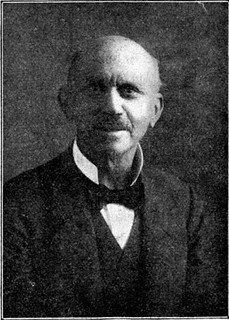
Adolf Ikle circa 1895 and 1922
Adolf Iklé-Steinlin (1852-1923), was born the ninth of twelve children in Hamburg, Germany in 1852. His father was a textile merchant who sold at Hamburg muslin goods bought at St. Gall, Switzerland. At the age of four Adolf began to go to school. By the age of six he already was a student of Latin and French languages. By age fourteen he became an instructor at Hamburg.
After moving to England and learning import and export trading in a global market he was groomed to join the family business at St. Gall, Switzerland. The family eventually set up their first textile factory manufacturing embroidery there about 1854 which later on was headed by Leopold Iklé (1838-1922), the elder brother of Adolf. Leopold would come to establish one of the largest and finest textile collections in the world donating in 1900 a large portion to the St. Gallen Textile Museum.
By the 1874 Adolf Iklé entered the business at St. Gall. There he married Agnes Schmidt and they had three children. After 17 years of marriage Agnes died. He then married Anna Steinlin.
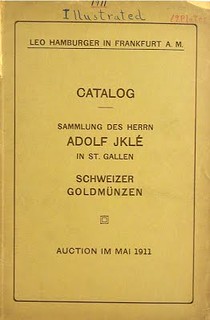
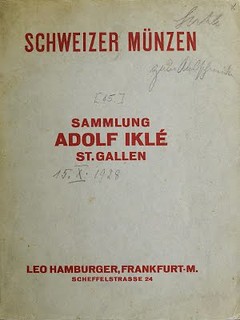
Leo Hamburger catalogs of the Iklé collection 1911 and 1928
In 1899 he joined the Swiss Numismatic Society SNS (Schweizerischen Numismatischen Gesellschaft) . At the 1903 annual SNS convention Adolf exhibited a large collection of Swiss coins and medals at his Villa Rosenberg. His passion for collecting reached its peak in 1911 when he seems to have lost interest and sold his collection through Leo Hamburger at Frankfurt a. M. on May 23, 1911.
It proved to be a very important collection of Silver and Gold coins and medals and significant in Zwingli portrait medals. With the assistance of E. Hahn, curator of the Numismatic Cabinet of the Swiss National Museum an extensive illustrated description of the Adolf Iklé collection was published in Revue suisse de numismatique, Band XVI and XVII.
To read the complete article, see:
IKLÉ-STEINLIN, ADOLF
(https://sites.google.com/a/numismaticmall.com/www/numismaticmall-com/ikle-steinlin-adolf)
The entire inventory of the Lupia Numismatic Library is for sale. Individual items will be available before the remaining archives are broken up into parcels sold at philatelic auctions in the U. S. and Hong Kong. Check NumismaticMall.com frequently as dozens of new items with estimates will be posted daily until everything is sold.
All inquiries will be given prompt and courteous attention. Write to: john@numismaticmall.com .

ROGER BLAND SPEAKS AT HARVARD

British coin expert Roger F. Bland—stopping through the United States to accept a prestigious award for his study of coins—visited campus Thursday evening to detail the history of ancient coin-finding to a group of roughly 40 University affiliates at the Harvard Art Museums.
Bland, who once served as the Keeper of Coins at the British Museum, spoke for about an hour, taking attendees through the history of the discipline: from simple digging in the 1500s to the modern-day method of using metal detectors to excavate coins.
Carmen Arnold-Biucchi, Curator of Ancient Coins at the Harvard Art Museums, said that she paid for Bland's visit using money drawn from Harvard's Ilse and Leo Mildenberg fund, a fund intended to promote the study of coins—called numismatics—at the University. She said she hopes Bland's visit taught Harvard affiliates the importance of the field.
“Numismatics in this country is still considered sort of an antiquarian discipline. In Europe, it is really part of academia,” Arnold-Biucchi said. “But here, it remains a hobby for collectors, so we are trying here at Harvard to emphasize that it is a very important historical discipline because coins are documents of ancient history.”
Bland stopped by campus just days after receiving the prestigious Huntington Medal Award at an Oct. 20 ceremony in New York City. The medal, according to the American Numismatic Society, is given in “recognition of outstanding career contributions to numismatic scholarship.” Arnold-Biucchi said the award is the “highest honor you can get” in the discipline.
In addition to discussing the history of coin-finding Thursday, Bland also spoke about his own history in the field. He said he first became interested in coin-finding because of his grandfather.
“I had a grandfather who was a big collector of coins, and he got me interested,” Bland said. “He collected English coins. But he said he didn’t want a rival collector, so he got me interested in Roman coins, which are much more common and cheaper to buy.”
Bland said he began his career in numismatic research at the British Museum as an intern—and remained there for the next 36 years. He said he worked his way up the chain, first serving as a curator in the Department of Coins and Medals before later moving to the Department of Culture, Media, and Sport.
“I was very lucky eventually to get a position there,” Bland said of his time at the museum.
Bland left the Museum in 2003 to found the Portable Antiquities Scheme, a project intended to establish a digital database of all ancient artifacts found in England and Wales. Bland said the goal of the initiative is to make this kind of information easily accessible to all archaeologists.
Since its founding over a decade ago, the database has accumulated more than 1.3 million artifacts, Bland said Thursday.
To read the complete article, see:
Harvard Art Museums Host British Coin Expert (http://www.thecrimson.com/article/2017/10/27/bland-coins/)
U.S. MINT ARTIST CHESTER MARTIN REMINISCES

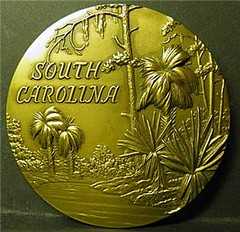
One such competition was for a design to commemorate the 50th anniversary of Brookgreen Gardens in South Carolina in 1981. I immediately took my family on vacation and I spent the entire time holed up making drawings to enter in that contest. And, very surprisingly, I WON - with strong competition from all the well-known established artists of New York and New England! (It was a very attractive $10,000 award that was offered, btw!) For that "win" I must be forever grateful to Mr. Joseph V. Noble, who was equally the Director of the Museum of the City of New York, AND of Brookgreen Gardens! He had the final say for selection of the Brookgreen Gardens medal. (And I was a total stranger to him and everyone else in the field at that time!) Folks, I have been very humble about that selection he made 35 years ago - for all the doors it has opened, and the richness it has brought to my life!
That 3-inch medal design was subsequently enlarged to a diameter of three feet (as per the contest Prospectus) and was placed in the permanent collection of Brookgreen Gardens (1981). It depicts a snail, whose shell is a spiral, sitting on a twisting vine, which is a spiral, and the snail looks out towards a spiral galaxy in space - fulfilling the theme, "The Natural World". (When first set in place inside the Palmetto Garden area, I was bowled over to discover it was just across from a large work of Paul Manship's - the noted sculptor that Miss Gail Hammond had spoken of at the university years before! (see above). Mr. Noble, Brookgreen's Director, then commissioned me directly to do a Membership medal for the Gardens, which was issued in 1984, and is pictured with this story. It shows flora and fauna of South Carolina, with a raccoon on one side and palmetto palms on the other.
At about the same time, AMSA (the American Medallic Sculpture Association) was requested to supply a medal for World Food Day, 1984. It was the first time such a request had been made of U.S. artists. Dr. Alan Stahl, AMSA's President at the time, sent the entire membership all the necessary information. I entered the contest - and, very surprisingly, won again! There were no drawings involved in the selection process - only the two finished plasters which were sent to Rome, Italy for minting. The medals were struck in gold, silver, bronze, and aluminum, before world-wide distribution. I later heard from Mark Jones, then Keeper of the Medals at the British Museum, that they had collected a copy. I was astounded to be represented in such a superior collection! I must be forever grateful to Dr. Stahl for "getting the word out" about that contest!
I have personal letters from Elvira Clain-Stefanelli, long time Executive Director of the National Numismatic Collections of the Smithsonian, and from Cory Gillilland, Curator of the same National Numismatic Collection, acknowledging my donation of coins and medals to the Smithsonian.
Soon after all these events, two openings in the Sculpture and Engraving Division of the U.S. Mint (Philadelphia) became available in the 6-person department - a rarity! Dr. Alan Stahl, then Curator of Ancient Coins at the American Numismatic Society in New York City - and President of the American Medallic Sculpture Association - again disseminated the notice to the entire membership. The job announcement and application form arrived in the same mailing, and, when I studied the job description, I kept shaking my head, thinking, "I could never do that!" The job application lay on my desk for several weeks before, at almost the last minute, I filled it out and mailed it in to the Mint. A few days later I had a long-distance call from Elizabeth Jones, then Chief Engraver of the U.S. My application had gotten their attention and I was to bring actual samples of my work - plaster-work, bronze medals, and painting - for my interview. (They wanted to see a bit of everything I did).
Ms. Jones selected two of her Engravers to sit in on the interview and review my work. These two were Edgar Zell Steever, IV, and John Mercanti. Together, the three of them selected me as one of the two new Mint Engravers! My head is still spinning with the excitement and disbelief I felt at the time! (Steever and I later were assigned to do a commemorative coin together - for the White House, 1792-1992. He sculptured the Mansion for the "heads" side, while I did the portrait of James Hoban - original White House architect - on the Reverse).
To read the complete article, see:
Chester Martin Remembers His Career As An Artist - The People Who Helped
(http://www.chattanoogan.com/2017/10/23/357186/Chester-Martin-Remembers-His-Career.aspx)
ROYAL AUSTRALIAN MINT ROAD SHOW

Coin collectors were in their element last week, when the Royal Australian Mint made a special trip to Deniliquin.
It was part of the mint's Trans-Australian tour — to celebrate the 100th anniversary of the Trans-Australian railway's development — with a tent set up on the Waring Gardens lawn area on the corner of Edwardes and Cressy Sts.
Passers-by could stop and get a special commemorative coin to celebrate the milestone.
The coin was stamped right in front of their eyes, making for a prized new addition to any collection.
The Royal Australian Mint's communications assistant Ben Beard said any interested community members could also trade in old coins for new ones, or pick up collectable coin sets.
‘‘It's about taking the minting out of Canberra and into the communities, and celebrating the Trans-Australian Railway, which successfully united the east and west of Australia,’’ Mr Beard said.
‘‘It was great to see a lot of people visit us and get their commemorative coin.
To read the complete article, see:
Mint stopover makes coin collector's dream
(http://www.denipt.com.au/2017/10/27/6901/mint-stopover-makes-coin-collectors-dream)

HISTORICAL MISSOURI SCRIP IN NEWMAN PART VIII
Diverse and Historical Missouri Scrip in Newman Part VIII
The upcoming Selections from the Eric P. Newman Collection Part VIII features a separate catalog (volume 2), dedicated to Eric's Missouri paper money collection. Most of the notes offered are cataloged for the first time and have been in Eric's collection for at least 75 years. Banknotes, financial documents, and scrip will be offered. The diverse and historical scrip notes commence in the Territorial period and continue into the 1870s and include a wide variety of genres and issuers. The sale will take place at the Heritage Auctions world headquarters in Dallas with the live auction on November 1 and the internet sale on November 2. Some highlights are below:
Lot 28341: A. T. Crane, Post Master at the St. Louis Post Office
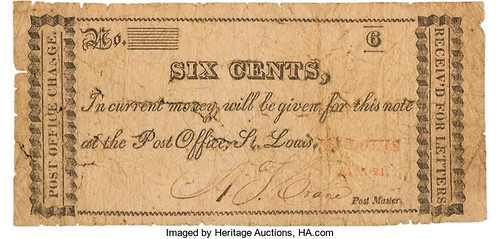
Possibly Unique St. Louis Post Office Pink Paper Postmarked 6 Cents Scrip: The postmasters of St. Louis issued the first printed currency notes in 1816. Aaron Crane issued two series of notes during his brief tenure as postmaster. The earliest series printed on pink paper is extremely rare and this six-cents is not only an odd denomination, but it is surcharged with a straight-line (as opposed to circular) postmark.
To read the complete lot description, see:
(St.
Louis, M.T.) - A. T. Crane, Post Master at the St. Louis Post Office, "Post Office Change/Receiv'd for Letters" 6 Cents ...
(https://currency.ha.com/itm/obsoletes-by-state/missouri/-st-louis-mt-a-t-crane-post-master-at-the-st-louis-post-office-post-office-change-receiv-d-for-letters-6-cents/a/3547-28341.s)
Lot 28475: 1862 French Point, MO $1.25 Scrip
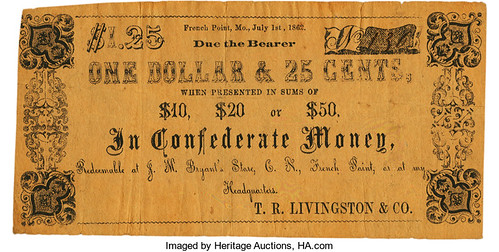
Superb T. R. Livingston French Point 1862 $1.25 Scrip Payable in the Cherokee Nation: Most private scrip, both from the North and the South, was created during the Civil War. Confederate-influenced scrip from Missouri is rare due the instability of the relatively few towns and small geographical area controlled, primarily in the southwest corner of the state. Some notes were issued from one location but payable at another, where the Confederate Army was in a stronger position. The T. R. Livingston notes, payable in the adjacent Cherokee Nation, are an example of this type of issue. This $1.25 note is payable “In Confederate Money” and one of the finest example known.
To read the complete lot description, see:
French Point,
MO - T. R. Livingston & Co. Redeemable at J. M. Bryant's Store, C.[herokee] N.[ation], or at my Headquarters $1...
(https://currency.ha.com/itm/obsoletes-by-state/missouri/french-point-mo-t-r-livingston-and-co-redeemable-at-j-m-bryant-s-store-c-herokee-n-ation-or-at-my-headquarters-1/a/3547-28475.s)
Lot 28528: 1872 Scotia Iron Works Store $5
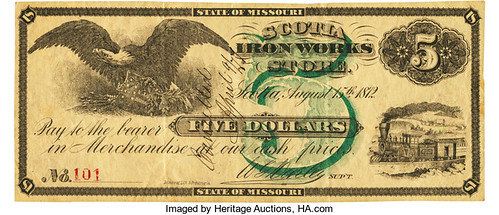
High-Grade and Stylish Scotia Iron Works $5 Note: Despite being prohibited by federal law, scrip notes continued to be issued after the Civil War. They were often essential for companies to pay workers or to float debt during financial panics, such as that of 1873. Iron mining was a significant Missouri industry, and several mines issued paper scrip notes. The five notes from the Scotia Iron Works Store in this sale are, to our knowledge, published and cataloged for auction for the first time. This $5, 1872-dated note has a Federal eagle at the upper left and has the appearance of an official government-issued note. It may be a unique example.
To read the complete lot description, see:
Scotia, MO - Scotia Iron Works Store $5
August 15, 1872. PCGS Extremely Fine 40.. ...
(https://currency.ha.com/itm/obsoletes-by-state/missouri/scotia-mo-scotia-iron-works-store-5-august-15-1872-pcgs-extremely-fine-40/a/3547-28528.s)
Lot 28551: St. Louis Omnibus Co. $3 Note
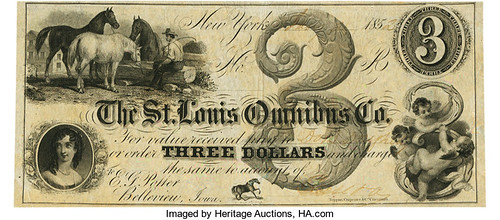
Highest Denomination St. Louis Omnibus Co. $3 Iowa Tie Note-Ex Wismer: Some privately issued notes were tied to other locations, either to be deceptive, skirt legal restrictions, or make redemption of legitimate notes more convenient. Eric classified these “tie” notes together in his collection, and they are grouped together in the catalog. Perhaps the most intriguing issue is the St. Louis Omnibus Co., with the title very dominant across the center. Eric specifically requested the three denominations in 1939 from D. C. Wismer after seeing them in an advertisement in The Numismatist. Although the series is payable in Belleview, Iowa, this is technically a New York City issuer.
To read the complete lot description, see:
New York,
(NY) - St. Louis Omnibus Co., "charge to account of...to E. G. Potter, Bellevue, Iowa" $3 18__ Oakes 7-3. Remainder...
(https://currency.ha.com/itm/obsoletes-by-state/new-york/new-york-ny-st-louis-omnibus-co-charge-to-account-ofto-e-g-potter-belleview-iowa-3-18-oakes-7-3-remainde/a/3547-28551.s)
Lot 28581: 1887 National Indian Ball Game Ad Note
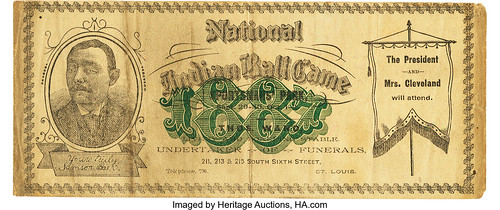
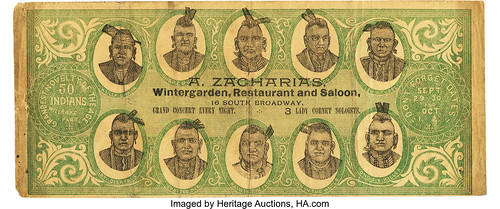
Extremely Rare 1887 National Indian Ball Game Ad Note: Advertising notes are not necessarily scrip, though sometimes they were redeemable for discount. Eric has several interesting ad notes, and his grandfather issued advertising notes printed on the back of Missouri Defence Bonds (retained by the family). One of the most intriguing American advertising notes is the very rare 1887 National Indian Ball Game type with portraits of actual Native American baseball players on the color back. The notes were issued by Thos. Ward of St. Louis for the games played at Sportsman's Park. We know of only one other example.
To read the complete lot description, see:
St.
Louis, MO - Thos. Ward, Livery and Boarding Stable-Undertaker of Funerals - 1887 National Indian Ball Game Advertising No...
(https://currency.ha.com/itm/obsoletes-by-state/missouri/st-louis-mo-thos-ward-livery-and-boarding-stable-undertaker-of-funerals-1887-national-indian-ball-game-advertising-no/a/3547-28581.s)
Bidding will close soon, and we wouldn’t want you to miss out on these wonderful Newman Collection notes. Please visit HA.com/3547 .
FOUR SIGNIFICANT CONFEDERATE PIECES TO BE SOLD
It's always an exciting event when an important piece of Confederate numismatica goes on the auction block – well, at least to me it is!
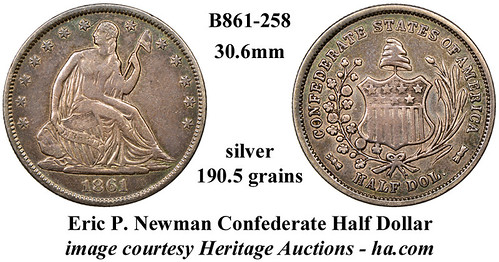
Only four of the famed Confederate half dollars were struck and one of those resides in the ANS collection, leaving just three available to collectors.
Of those three, the specimen thought to have belonged to President Davis was sold in the October 2003 Stack's Bowers Galleries Auction of the fabled John Ford collection to Donald G. Partrick for $632,500. Mr. Partrick later sold his coin in the January 2015 Heritage Auctions sale for $881,250.
A second specimen, thought to have been originally presented to John Leonard Riddell, was purchased by Henry P. Kendall who later sold it in a March 2015 auction by Stack's where it realized $646,250.
The specimen now offered by Heritage Auctions is from the Eric P. Newman Numismatic Education Society and this is its very first public auction appearance, having been held by the society for many years. The added significance of this sale is that all three privately held Confederate half dollars will have appeared at auction since 2015. With all three coins now likely to be in strong hands, the probability of another auction appearance by one of these rarities in the foreseeable future is quite small indeed.
Auction November 1-3, 2017:
To read the complete lot descriptions, see:
1861 50C Original
Confederate States of America Half Dollar PR40
(https://coins.ha.com/itm/confederate-states-%20of-america/1861-%2050c-original-%20confederate-states-%20of-america-%20half-dollar-%20pr40-ngc-%20cac/a/1260-15125.s)

Most collectors have at least a passing familiarity with these J. W. Scott white metal tokens. After Scott acquired the Confederate Half Dollar reverse die in 1879, he planned to stamp the Confederate reverse over the existing reverse on 500 US Half Dollars, thereby producing the “Scott Confederate Half Dollar Restrikes”. Before risking the potentially fragile die on the hard silver coins, however, Scott and his assistant, David Proskey, deemed it advisable to strike 500 tokens in softer white metal so that they would at least have something to deliver to their customers if the Confederate die broke. The die survived both the tokens and the silver restrikes and the rest, as they say, is history.
But now comes a fascinating footnote to the story – prior to striking his white metal tokens, Scott apparently first struck some die trial pieces in brass and three of those previously unknown trials will be auctioned by Stack's Bowers Galleries (From the estate of F.C.C. Boyd, May 1954).
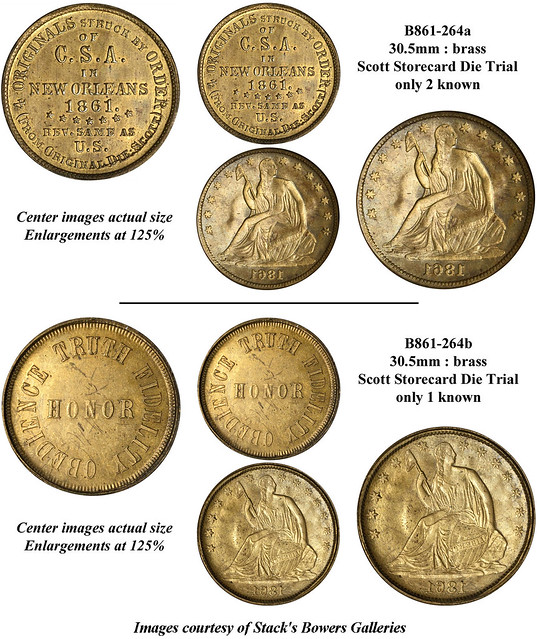
All three were struck on thin, well made, brass planchets using an 1861 half dollar coin as the reverse die, thus creating a reversed impression of the Liberty Seated design on the planchet. Two of the trial pieces employed Scott's storecard type die for the obverse, and the third obverse die has HONOR in the center, with OBEDIENCE TRUTH FIDELITY around – a die with which I’m not familiar.
Auction November 10, 2017
To read the complete lot descriptions, see:
(1879) J.W. Scott Confederate half dollar restrike die trial. Brass, 30.5 mm. Choice Mint State.
(https://auctions.stacksbowers.com/lots/view/3-8OUT4)
(1879) J.W. Scott Confederate half dollar restrike die trial. Brass, 30.4 mm. Choice Mint State.
(https://auctions.stacksbowers.com/lots/view/3-8OUTB)
(1879) J.W. Scott Confederate half dollar restrike die trial. Brass, 30.5 mm. Choice Mint State.
(https://auctions.stacksbowers.com/lots/view/3-8OUTI)
Peter Bertram
peterb1861@gmail.com
www.ConfederateNumismatica.com
NUMISMATIC NUGGETS: OCTOBER 29, 2017
1713 Landau Siege of French Troops


GERMANY, Landau. Siege coinage of French Troops. 1713 AD AR Klippe, 21.47g (46mm). One-sided 'klippe' for 2 gulden and 8 kreuzer.
The year was 1713 and the Treaty of Utrecht was signed with the exception of the Holy Roman Empire (Germany) and the Habsburg dynasty. In order to force the hand of the Germans, the French, which were already militarily depleted, were able to assemble a large army consisting of 300 squadrons and 240 battalions. The army was led by Marshall Claude Villars, a successful French army commander. With the revived military might of the French under the leadership of Villars, The Holy Roman Empire acquiesced and signed the Peace Treaty of Rastatt the following year.
Siege coinage was emergency currency, hastily made from old dishware or pieces of metal, and were pushed into the hands of soldiers to compel them to fight. This particular piece has official currency of 2 gulden and 8 kreuzer pressed into the metal.
References: Dav. 2377; Klein/Raff 220.4
To read the complete lot description, see:
GERMANY, Landau. Siege coinage of French Troops. 1713 AD (http://www.shannaschmidt.com/coin-of-the-week/)
1971 Andy Warhol Art Cash-Ones
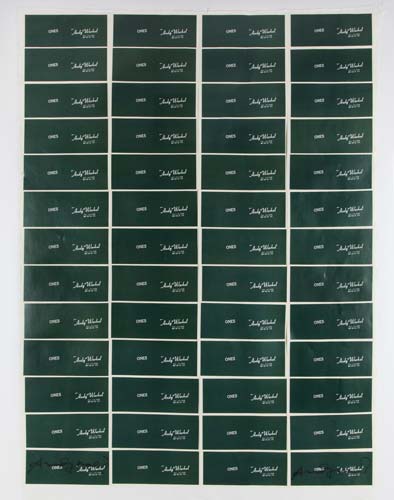
Art Cash - Ones, 1971
Colored offset on paper, 93 x 60 cm
Collection of fiftytwo Art Cash-Ones, two of them signed on the front with marker
Print American Banknote Company
EXIBITIONS
Pop Icons, Restelliartco Gallery, Rome, from January 20, to February 6 2015
PROVENIENCE
Private collection
The banknotes have been realized for the fundraising to support the Experiments in Art and Technology - E.A.T. to use at the casino gaming tables to purchase the donated art work. Every banknote has been invented by a different artist, Raushenberg, Whitman, Gormley, Grooms and Marisol. Warhol creates the 'One' banknote, printed by the American Banknote Company, with the same paper used for the United States currency. One sample alone has been sold for $ 300
To read the complete lot description, see:
LOT 543 - AUCTION 38 - MODERN AND CONTEMPORARY ART - ROME - 21-22 NOVEMBER 2017
(https://auctions.bertolamifinearts.com/en/lot/19848/andy-warhol-pittsburg-1928-new-york-/)
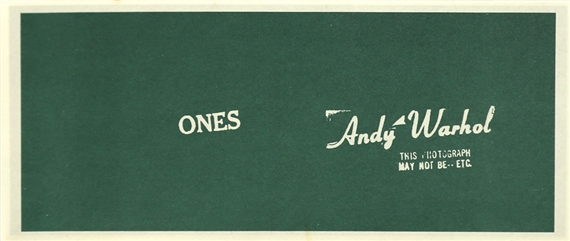
The "Art Cash" bills, printed by the American Banknote Company that was the then printer for the United States Treasury, were used for the Experiments in Art and Technology's (E.A.T.) benefit at a private casino party at Automation House, New York in December, 1971. The artists, Andy Warhol, Robert Whitman, Robert Rauschenberg, Tom Gormley, Red Grooms and Marisol, all contributed bills of different values for the event.
To read the complete lot description, see:
Ones Art Cash , 1971 (https://www.mutualart.com/Artwork/Ones-Art-Cash/440B2208516290EB)
1976 Gold Bicentennial Medal
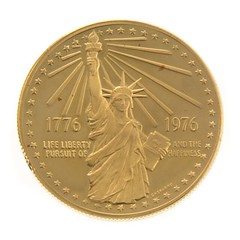
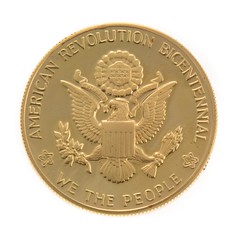
Description: 1976 American Bicentennial Gold Medal. 40.5 grams of 90% gold AGW of 1.17 Oz Gold. In very nice wooden mint presentation box
To read the earlier E-Sylum article, see:
GASPARRO'S 1976 BICENTENNIAL GOLD MEDAL (http://www.coinbooks.org/esylum_v18n10a10.html)
To read the complete lot description, see:
Lot 650: [US] 1976 Gold Bicentennial Medal (https://www.invaluable.com/auction-lot/-1-c-87042BEA48)
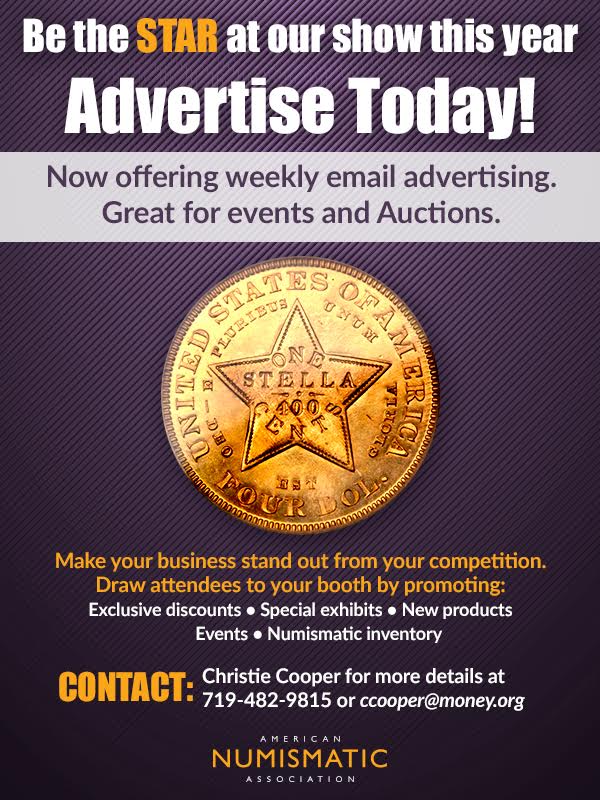
WAYNE'S NUMISMATIC DIARY: OCTOBER 29, 2017
2017 U.S. Mint Forum
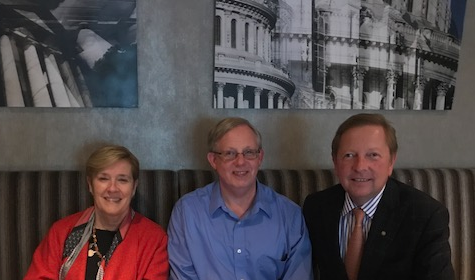
Mary Lannin, Wayne Homren, Tom Uram
First, a follow-up from last week's diary. Following the 2017 United States Mint Numismatic Forum at the Mint headquarters in Washington, D.C., I met Tom Uram for a happy hour beverage with Citizen's Coinage Advisory Committee chair Mary Lannin.
Tom asked our server to take the photo. We had a great casual conversation on topics including the upcoming Pennsylvania Association of Numismatists (PAN) show, personal travel, coins with dogs, The E-Sylum, and of course, the day's events at the forum. It was a great way to relax before hitting the rush hour traffic for my ride home.
To read the earlier E-Sylum article, see:
WAYNE'S NUMISMATIC DIARY: OCTOBER 22, 2017 (http://www.coinbooks.org/v20/esylum_v20n43a17.html)
ANS Money Talks: The Future of Digitization
Last Friday morning I hit the road again, this time pointing my car toward New York City. My wife and two of our three children were aboard for the ride. While I would be spending Saturday afternoon
at the American Numismatic Society forum on The Future of Digitization, they would be seeing the sights of the city, to include a trip to the Statue of Liberty.
The weekend weather was marvelous. While they walked down to Battery Park from our Tribeca hotel after breakfast Saturday morning, I was taking in the indoor sights at the ANS. Here are some of my photos.
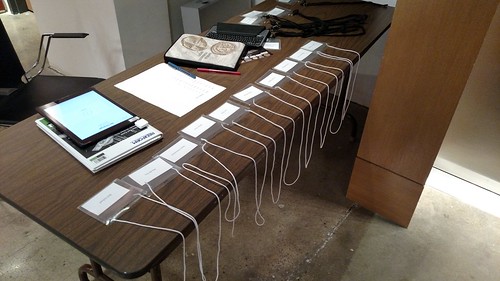
Registration
After checking in with security in the building lobby and at the guard station at the entrance to ANS spaces on the 11th floor, I met ANS Membership Assistant Emma Pratt, who was manning the registration desk. I got my badge, paid my fee and also picked up a book from the library's duplicate sale.
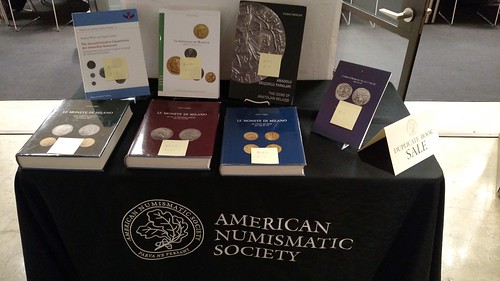
ANS Library Duplicate Sale Table
Had I snapped a Before photo I could ask, "Which one is missing?" after making my own purchase.

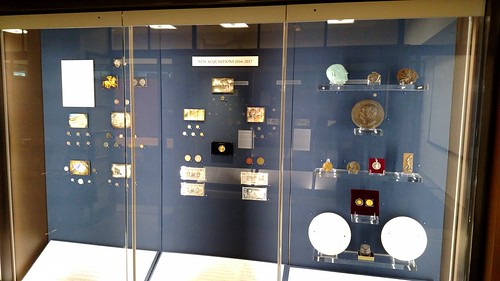
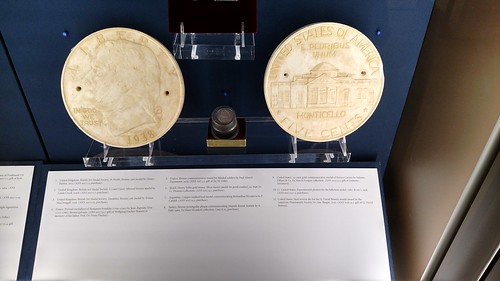
The exhibits held some amazing material, including this proposed design for the Jefferson Nickel.

Librarian David Hill was open for business during the event. Here are shelves holding new purchases. Readers may recognize some titles we've discussed here recently - David noted that a number of these purchases followed announcements of new books in E-Sylum.
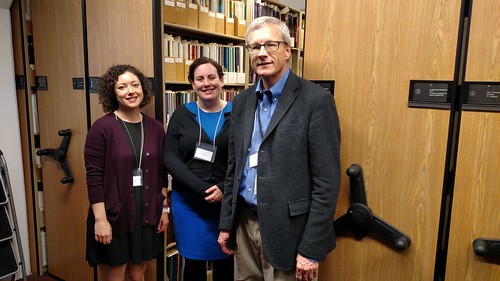
Shannon Davis, Nicole Fry, Len Augsburger
I was participating on behalf of the Newman Numismatic Portal, and joined the rest of our delegation for a library tour before the forum started. I took this shot in front of the library shelves. From left to right are Washington University in St. Louis employees Shannon Davis, Nicole Fry and Len Augsburger, the NNP Project Coordinator. It was humbling to see the vast extent of just one numismatic library's holdings and realize that we've only barely scratched the surface of the space with the 1.6 million pages currently in NNP.
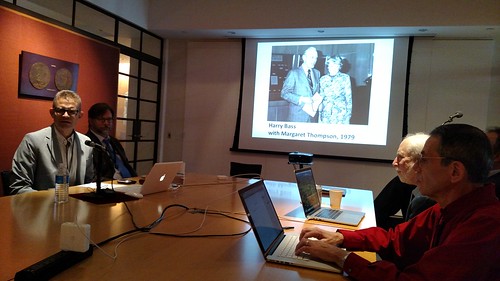
I'm no professional photographer, and it shows. The lighting is horrible in this shot as David Hill began his talk. It focused on the history of digitization at the ANS, beginning with work sponsored by donor Harry Bass. I never met the Texas billionaire in person, but we were heavy email pen-pals.
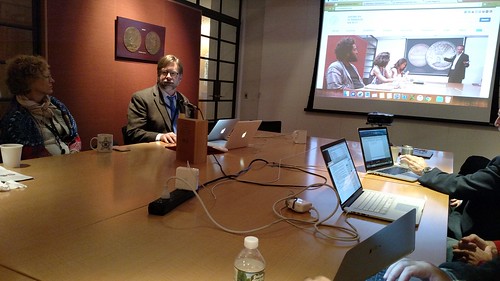
Here Publications Director Andrew Reinhard speaks with Executive Director Ute Wartenberg Kagan on the left.
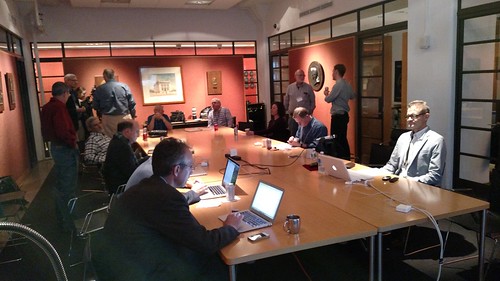
Here's a shot during one of the breaks. Participants included Victor England of Classical Numismatics Group, ANS Greek Coins Curator Peter van Alfen, David Bailey, Jim Neiswinter, Matthew Ruttley, Eric Krauss and Jay Galst.
Victor and I planned to exchange URLs of useful web sites for numismatic research. Several people I met for the first time including Dave Bailey, who has a numismatic photo collection he may share on NNP, and who will help me reach out to the Garden State Numismatic Society in New Jersey about digitizing their back journals. I learned that like myself Matthew works as a Data Scientist and we shared some ideas for future NNP features.
The conversations on the breaks and at the wine reception afterward were quite enjoyable. Here are a couple more photos from the ANS offices.
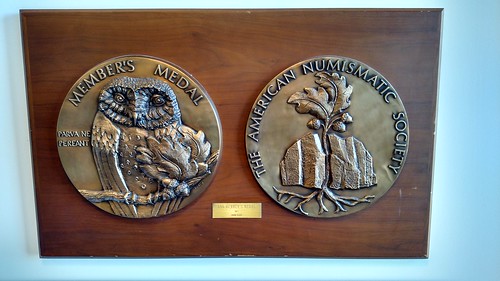

Afterwards I walked back to my hotel with Nicole, who was also staying at the Hilton Garden Inn. My family and I crowded into a cab which took us uptown to a favorite Italian restaurant. From there we walked over to Times Square and enjoyed the sights and sounds (but not the crowds), picking up some souvenirs and clothing.
Another taxi took us back to Tribeca where we met Len Augsburger in the hotel lobby. Len and I retreated to the hotel restaurant for an enjoyable two-hour meeting over drinks on the sidewalk patio. We discussed all the day's events, and current and future plans for the Newman Numismatic Portal.
That was it for the numismatic part of my trip. The next morning my family and I wandered around Tribeca, Soho and Greenwich Village, having breakfast and enjoying the sights of New York. Around 11am we picked up my car and headed through the Holland Tunnel toward Virginia. After arriving home we unpacked and split up for dinner - I stayed home with the menfolk and ordered takeout to watch our hometown football team play. After the Steelers wrapped up a win I worked to finish The E-Sylum before calling it a day.
For those who missed the event, follow the ANS YouTube channel for the videos. Some of the talks have already been posted, so follow the links below.
To view the ANS Money Talks Future of Digitization videos, see:
Money Talks, The Future of Digitization, Part 2: Dr. Peter Van Alfen discusses the implementation of digital database projects at the ANS.
(https://www.youtube.com/watch?v=psetgEps3Y0)
Money Talks, The Future of Digitization, Part 3: Andrew Reinhard, Director of Publications, outlines digital initiatives for publishing
numismatic literature at the ANS. (https://www.youtube.com/watch?v=hUzKG3HeyWI)
Money Talks. The Future of Digitization, Part 4 : Len Augsburger of the Newman Numismatic Portal discusses joint digitization projects with the
ANS. He also outlines the functions of The Internet Archive and integration with the ANS's Donum. (https://www.youtube.com/watch?v=AlRlvPKjR30)
To read the earlier E-Sylum article, see:
ANS MONEY TALKS: THE FUTURE OF DIGITIZATION (http://www.coinbooks.org/v20/esylum_v20n42a08.html)
DIX NOON WEBB OFFERING EARLY PROOF SETS
Two superb early 19th century proof sets which are on the market for the first time in almost 80 years will be among the highlights of the auction of Coins, Historical Medals and Paper Money to be held by the international specialists Dix Noonan Webb in London on 13 to 14 December 2017. The sale will also include a fine selection of English Five Guineas gold coins with dates ranging from 1692 to 1729.

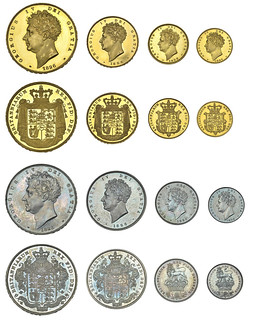
A proof set of eight coins bearing the head of George IV and dated 1826 is expected to sell for £100,000 to £120,000. The set comprises four gold coins – Five and Two Pounds, Sovereign and Half-Sovereign – and four silver coins – Crown, Halfcrown, Shilling and Sixpence – displayed in a 19th century custom-made gilt-blocked case. The catalogue describes the set's condition as “minimal hairlining, about mint state and brilliant, the silver with dark matching tone”. The set was last on the market when it was auctioned on 24 February 1938 selling for £35. It has remained with the family of the purchaser ever since.
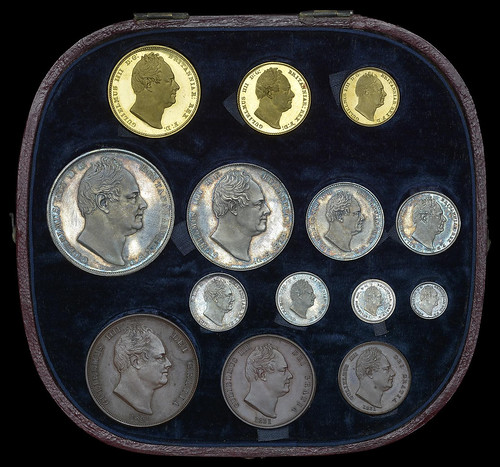
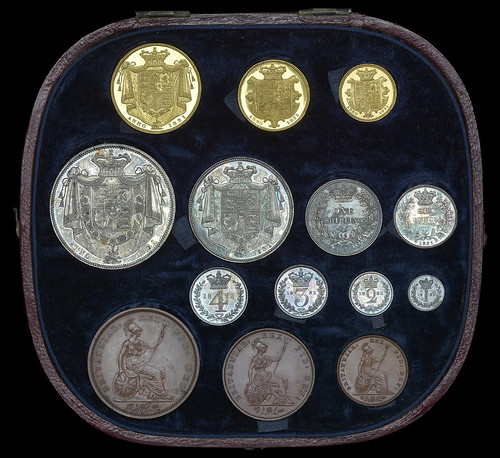
The second proof set, which comes from the same source, is from the reign of William IV and is dated 1831. The 14 coins in the set comprise gold Two Pounds, Sovereign and Half- Sovereign, silver Crown, Halfcrown, Shilling, Sixpence and Maundy set and copper Penny, Halfpenny and Farthing. All are housed in a contemporary maroon fitted case. The catalogue describes their condition as “gold and silver with some light handling marks and hairlines, particularly on the larger coins, the silver with matching tone, these better than extremely fine and brilliant, the copper similar but a little cloudy”. The set has not appeared on the market since 4 March 1938 when it fetched £33 at auction. It has remained with the family of the purchaser ever since. It is expected to sell for £40,000 to £50,000 at the Dix Noonan Webb sale.
A selection of five gold Five Guineas coins will also be auctioned by Dix Noonan Webb. Two, bearing the head of William III, date from 1701 and are estimated at £20,000 to £26,000. Another, carrying the same estimate, is from the reign of George II dated 1729. A William III coin dated 1699 is expected to fetch £14,000 to £16,000 while another Five Guineas with the joint heads of William and Mary and minted in 1692 is estimated at £12,000 to £15,000.
For more information on the sale, see:
https://www.dnw.co.uk/
MUSEUM OF LONDON EXHIBITS ALTERNATIVE CURRENCY

The Museum of London is opening its latest display: (Un)common Currency which explores the use of alternative currencies in London since the 17th century.
Through these unconventional currencies, Londoners have built communities based on trust, furthered political causes and helped develop a thriving local economy. Some currencies radically dispense with a ‘face value’ and instead value people's time by the hour.
Vyki Sparkes, curator at the Museum of London, said: “From copper trade tokens from the 17th century to time credits and the Brixton pound, it's fascinating to see examples of how Londoners have created alternative currencies to try to deal with the political, social and personal challenges of their times. Through this display we want to provoke visitors to consider the relevance and future of alternative London currencies.”
Examples on display include:
• 17th century trade tokens. These tiny copper tokens were developed when change became in short supply. Whilst the wealthy used credit, everybody else needed a way to do business so traders created their own tokens. Each token includes names, initials and symbols of people and their businesses.
• One penny coin from 1910. This penny has been defaced with the demand ‘Votes for Women’ stamped on King Edward VII's head. Suffragettes chose to deface low value coins so their political message would circulate widely.
• Tally sticks. These sticks recorded debt, with each notch representing one, ten or a thousand pounds depending on its depth. Each stick was broken into two halves – for the lender, and the borrower. In 1826 Parliament abolished the tally system, but when they burnt the tally sticks the fire accidentally destroyed both Houses of Parliament.
• Brixton Pound. These notes were designed to encourage local spending and its vibrant series of notes celebrates the area's people and places. The B£5 note features professional basketball player Luol Deng who fled war-torn Sudan and went on to represent the UK in the London 2012 Olympics.
The display forms part of City Now City Future, the museum's year-long programme exploring urban life in London and around the world. The City is Ours, the museum's major, free exhibition, is also open and uncovers the joys and frustrations of city living.
To read the complete article, see:
Museum of London takes stock of alternative currency in London
(http://artdaily.com/news/99296/Museum-of-London-takes-stock-of-alternative-currency-in-London-#.WfYzUmhSyAs)
STATUE DEDICATED TO DICKIN MEDAL DOG
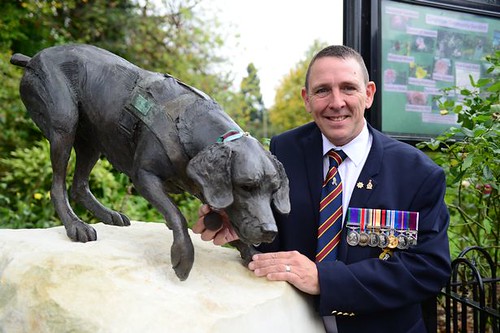
Hero dog Treo has been immortalised with a £14,000 bronze statue in tribute to his bravery in sniffing out explosives in Afghanistan.
The fearless black Labrador is credited with saving a huge number of lives in the country and was even awarded with the animal equivalent to the Victoria Cross – the Dickin Medal.
A special sculpture of the dog, who passed away in 2015, was unveiled in Congleton's Community Garden after a fund-raising effort in the town generated £14,912.
His handler Dave Heyhoe, who is now retired, said the statue was ‘absolutely amazing’ and a fitting tribute to his beloved Treo.
The 48-year-old, of Congleton, said: “We had such a bond that he wouldn’t work for anyone else. He was a fiery character.
“We were in a place called Sangin which at the time it was known as 'IED alley' as there were IEDs ( improvised explosive devices) everywhere.
“I was deployed with Treo to look for these IEDs on a daily basis. We were so successful out there that Treo was awarded the animal Victoria Cross for the amount of devices he found.
Dave, who wrote a book about his experiences in the war-torn country with his dog, is also pleased families in Congleton can learn about Treo's valiant efforts.
“He's immortalised now and it really does look like him. Everyone will be able to look at him now and see that he did that job for his country.
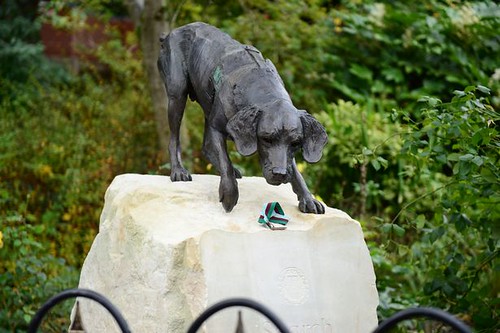
Sculptor and portrait artist Amy Goodman had read Dave's book - It's All About Treo: Life and War with the World's Bravest Dog - before she was approached. The talented sculptor who has produced a number of works centred on animals, said: “I’ve always loved animals and to be involved with something so personal has been quite emotional.
“I met Dave not long after Treo died. I wanted to capture the character of the dog so started looking at video footage of Treo and doing a lot of research.
“I wanted the sculpture to be quite high up so you could see the intensity in his face. I’m really happy with how it looks and it's in a lovely place.
To read the complete article, see:
Stunning £14k statue of a hero DOG who sniffed out explosives unveiled in town
(http://www.stokesentinel.co.uk/news/local-news/stunning-14k-sculpture-brave-army-685791)
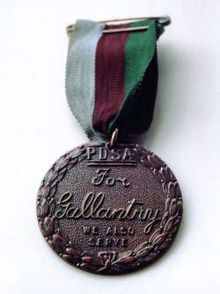 The PDSA Dickin Medal was instituted in 1943 in the United Kingdom by Maria Dickin to honour the work of animals in World War II. It is a bronze medallion, bearing the words "For
Gallantry" and "We Also Serve" within a laurel wreath, carried on a ribbon of striped green, dark brown, and pale blue. It is awarded to animals that have displayed "conspicuous
gallantry or devotion to duty while serving or associated with any branch of the Armed Forces or Civil Defence Units". The award is commonly referred to as "the animals' Victoria
Cross" (although the Victoria Cross Trust has opposed this association).
The PDSA Dickin Medal was instituted in 1943 in the United Kingdom by Maria Dickin to honour the work of animals in World War II. It is a bronze medallion, bearing the words "For
Gallantry" and "We Also Serve" within a laurel wreath, carried on a ribbon of striped green, dark brown, and pale blue. It is awarded to animals that have displayed "conspicuous
gallantry or devotion to duty while serving or associated with any branch of the Armed Forces or Civil Defence Units". The award is commonly referred to as "the animals' Victoria
Cross" (although the Victoria Cross Trust has opposed this association).
Maria Dickin was the founder of the People's Dispensary for Sick Animals (PDSA), a British veterinary charity. She established the award for any animal displaying conspicuous gallantry and devotion to duty whilst serving with British Empire armed forces or civil emergency services. The medal was awarded 54 times between 1943 and 1949 – to 32 pigeons, 18 dogs, three horses, and one ship's cat – to acknowledge actions of gallantry or devotion during the Second World War and subsequent conflicts. The awarding of the medal was revived in 2000 to honour Gander, a Newfoundland dog, who saved infantrymen during the Battle of Lye Mun. In early 2002, the medal was given in honour of three dogs for their role responding to the September 11 attacks; it was also awarded to two dogs serving with Commonwealth forces in Bosnia-Herzegovina and Iraq. In December 2007, 12 former recipients buried at the PDSA Animal Cemetery in Ilford, Essex, were afforded full military honours at the conclusion of a National Lottery-aided project to restore the cemetery.
The first recipients of the award, in December 1943, were three pigeons, serving with the Royal Air Force, all of whom contributed to the recovery of air crew from ditched aircraft during the Second World War. The most recent animal to be cited for the honour is Reckless, a horse who was injured while serving with the United States Marine Corps in the Korean War. As of April 2016, the Dickin Medal has been awarded 67 times, with Diesel's presentation to take place later in the year.
To read the complete article, see:
Dickin Medal (https://en.wikipedia.org/wiki/Dickin_Medal)

